What To Wear Hiking In Banff & the Canadian Rockies
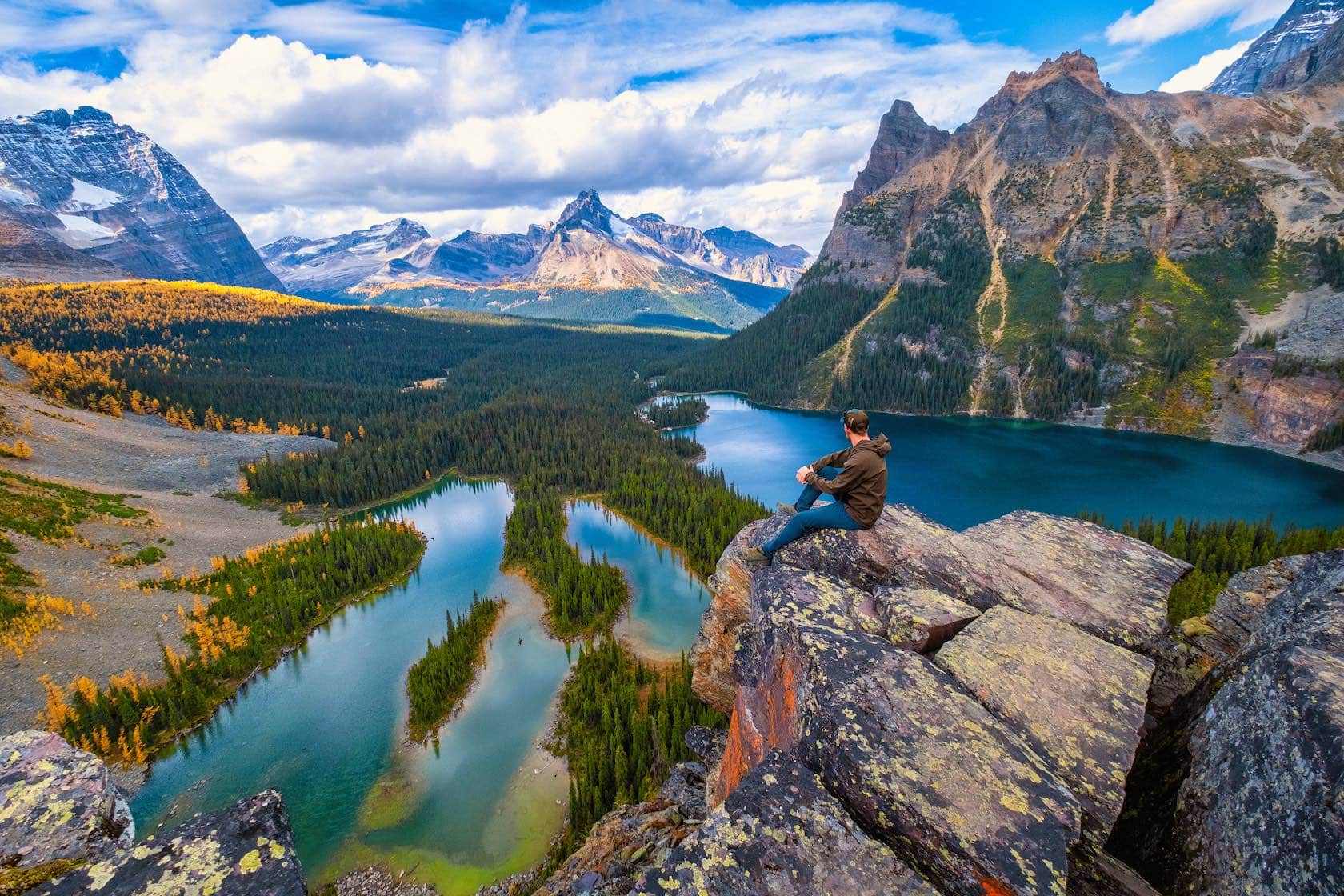
Don’t worry about what to wear hiking in Banff & the Canadian Rockies. We suggest you head out in whatever is comfortable, but never forget a jacket, phone, bear spray, and water. Most hikers don’t need a new wardrobe with the latest and greatest tech for a simple hike to scenic viewpoints. Save the fancy gear for the mountaineers and those pushing boundaries.
A smart strategy regarding clothes is still a good idea. Every hiker needs solid fundamentals as they delve deeper and reach loftier heights. The right clothes can save your life when hiking the Canadian Rockies in an emergency. At the very least, the right gear makes for a more pleasant day on the trail.
Cold weather, sunburn, blisters, rain, and bugs can ruin any unprepared hiker’s day. I can attest that the right clothing is the difference between a good day and a bad one. We have seen it all in weather and trail conditions.
Tips For What to Wear Hiking
Make Your Plans
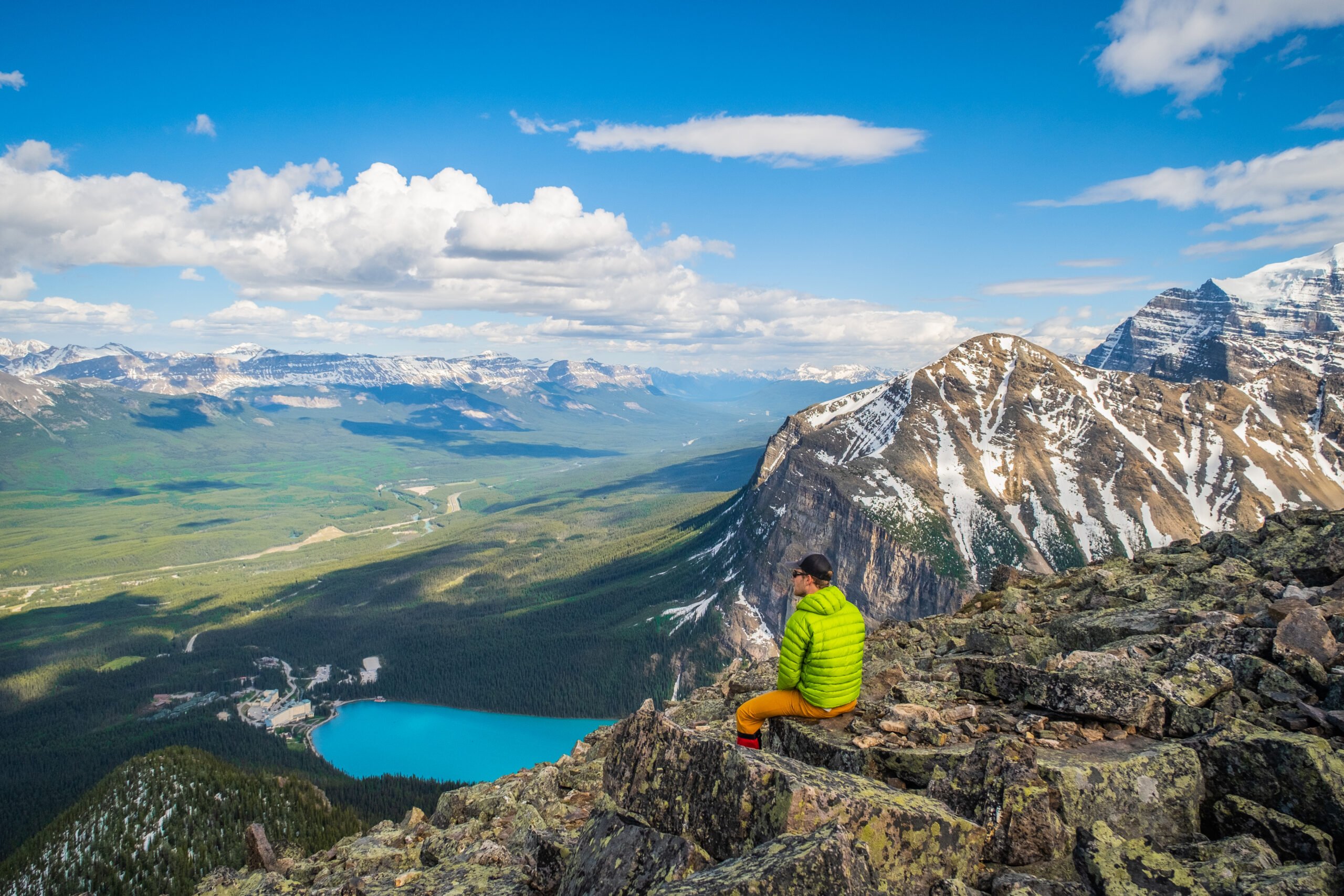
Every hike, run, scramble, or mountaineering objective starts with the planning phase. Walking through the forest to a waterfall in the summer is not the same as summiting a mountain in the winter. As your hikes and objectives reach further into the park and higher elevations, the weather plays a large role in your choices.
Personally, we always research the route and understand what kind of terrain we will face on our hike. Knowing the route’s topography and checking the weather forecast is a good idea. I check the weather on every hike, ski, or bike and pack conservatively based on forecast conditions. It’s best to be prepared for the worst and be surprised by the best.
A great resource for checking the weather is Mountain Forecast and Windy, which forecasts temperatures, precipitation, and wind speeds at various elevations. Various webcams throughout the mountains are a great resource to check conditions before you arrive at the trailhead.
Weather In The Canadian Rockies
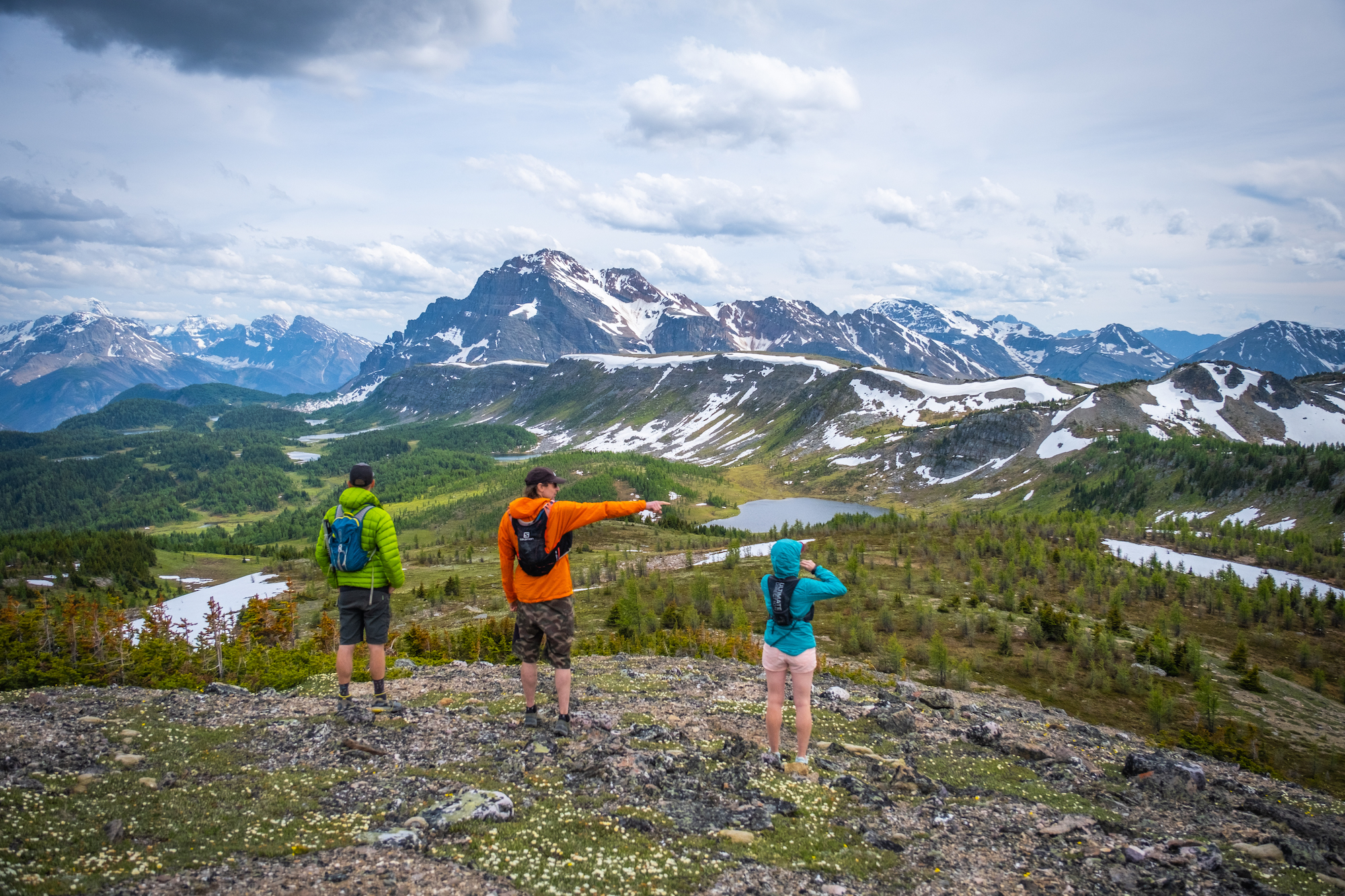
We enjoy great hiking weather in the Canadian Rockies. We love that we generally don’t have to worry about avoiding the midday heat or stress about dehydration. Summers are very mild, and high-elevation passes and summits are almost always cold. That’s not to say we don’t have warm summer days where we wear shorts and a T-shirt, especially in the valley bottoms.
However, it shouldn’t be too surprising, but with elevation and climate, it’s generally colder. Unless we’re on a very simple hike, we pack a jacket for every hike, and anyone with plans to visit will want to bring some good outerwear. For outfits, we generally wear what you see above in the photo: shorts, shirts, and a jacket.
Layers
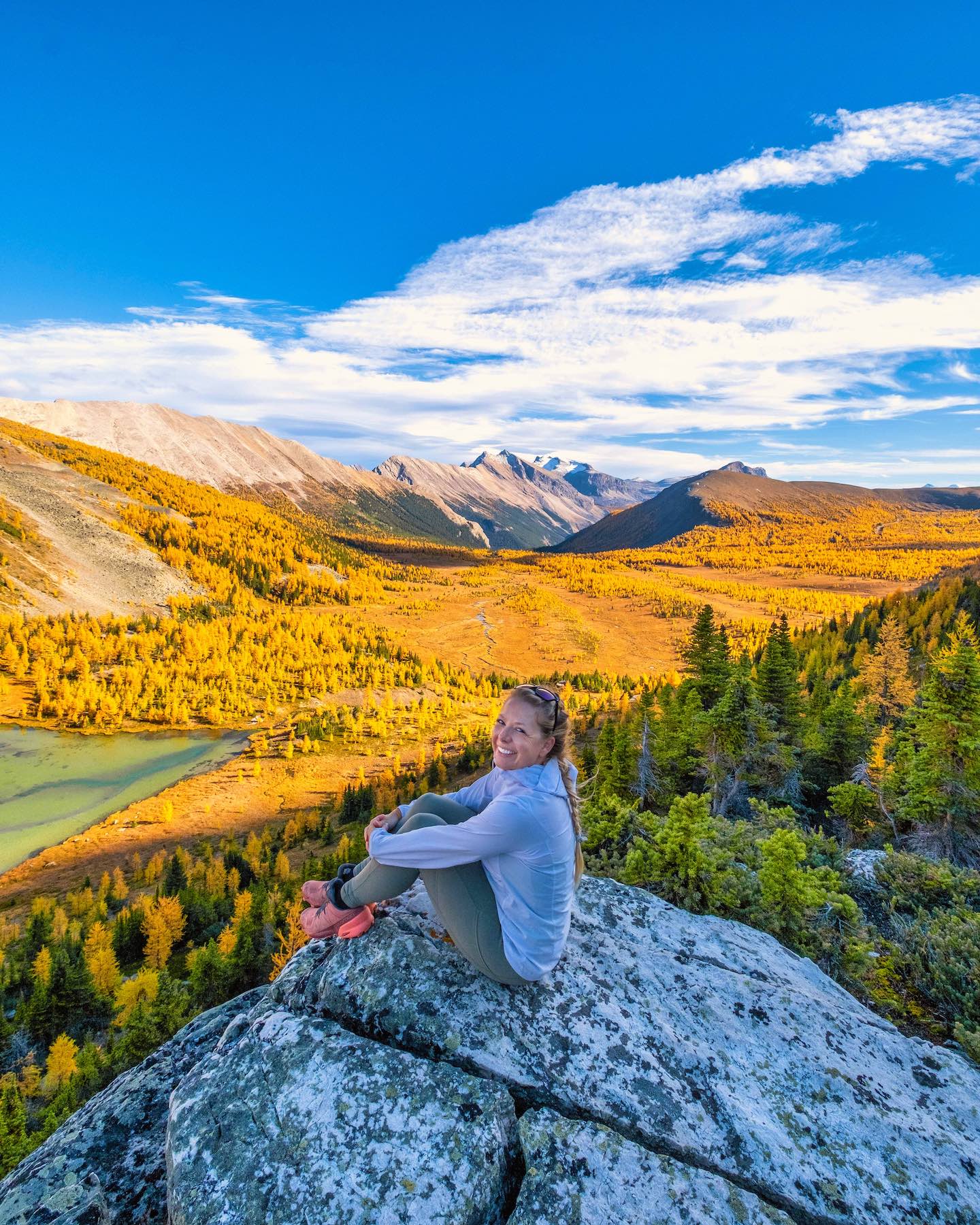
The most basic principle of what to wear hiking is layering. Anyone who has spent time in the wilderness or mountains can say your temperature fluctuates significantly on a hike. I’ve always been a fan of the “be bold and start cold” saying, which means I dress with physical exertion in mind. That way, I don’t sweat once I begin exerting myself, but I can always wear a jacket if it’s too cold. Layers provide the best protection from the elements, allowing hikers to regulate their temperature.
The key to comfort and warmth in the mountains is remaining dry. A sweaty shirt at elevation will pull away your precious body heat and leave you feeling chilly. This system may not be as important for short hikes at low elevations in the summer, but since most hikes in the Rockies occur at high elevations, hikers will deal with cold temperatures.
As you venture further into the backcountry, the risk of spending the night outside also presents a greater threat, so additional layers are paramount to a safe hike. You do not want to stay in the Rockies without some warm clothing. It’s happened to many unsuspecting hikers throughout the years.
Choose The Right Materials
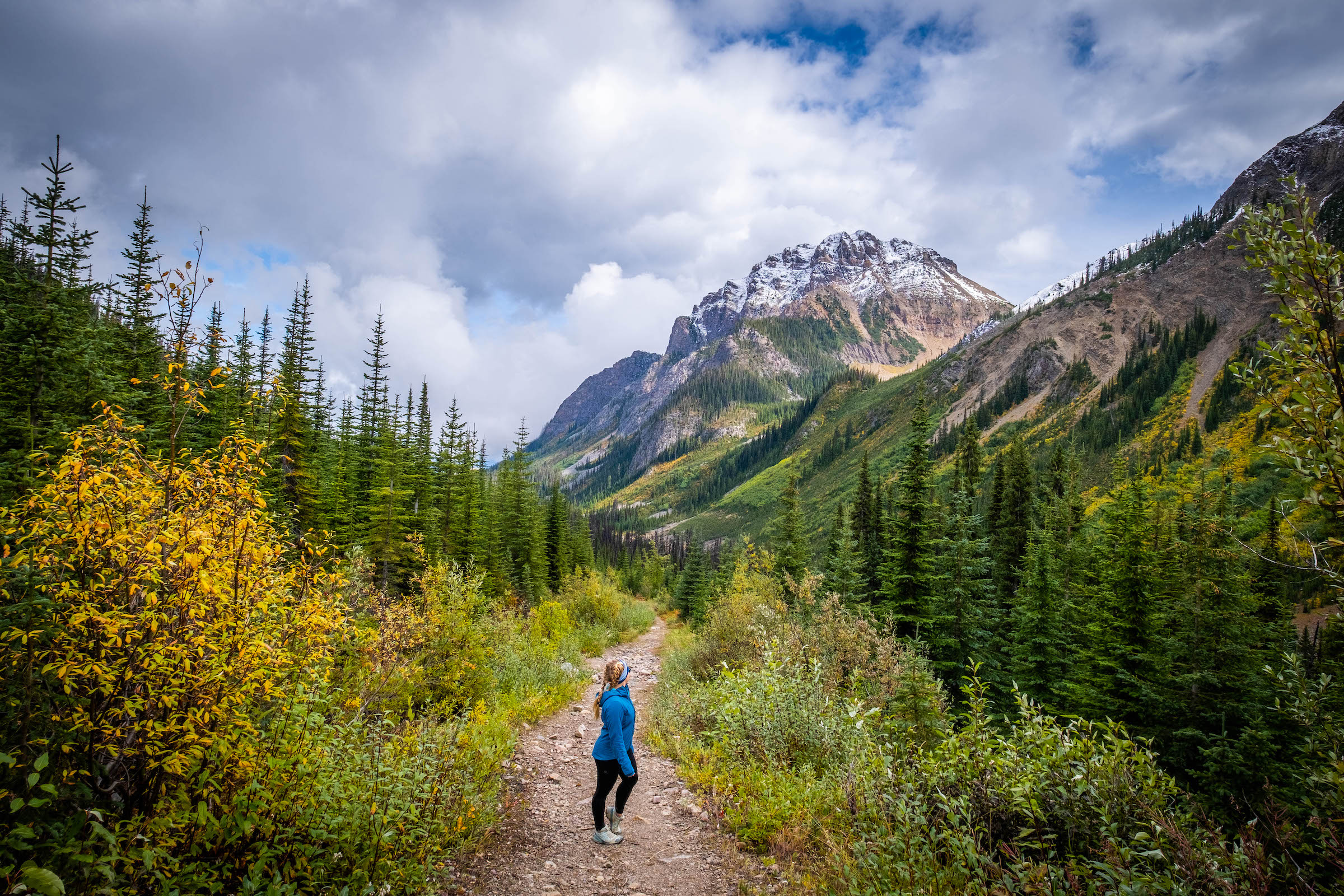
While layers help manage temperature, the choice of material is equally important. Synthetic materials dry fast thanks to their moisture-wicking qualities. If clothes fail to dry once you’ve stopped moving, you’ll find you develop a chill fast. It’s best to avoid cotton as it is slow to dry and heavy. Synthetic fabrics like nylon and polyester are breathable, wick moisture away, and are durable.
If possible, opt for recycled, Bluesign-certified, or natural fabrics. For a more natural choice, try wool or canvas. While wool is more expensive, it offers great comfort and performance. The best thing about wool is that it’s not a petroleum-based product. I love my wool clothing, but my wallet certainly doesn’t!
Invest In Your Hiking Attire
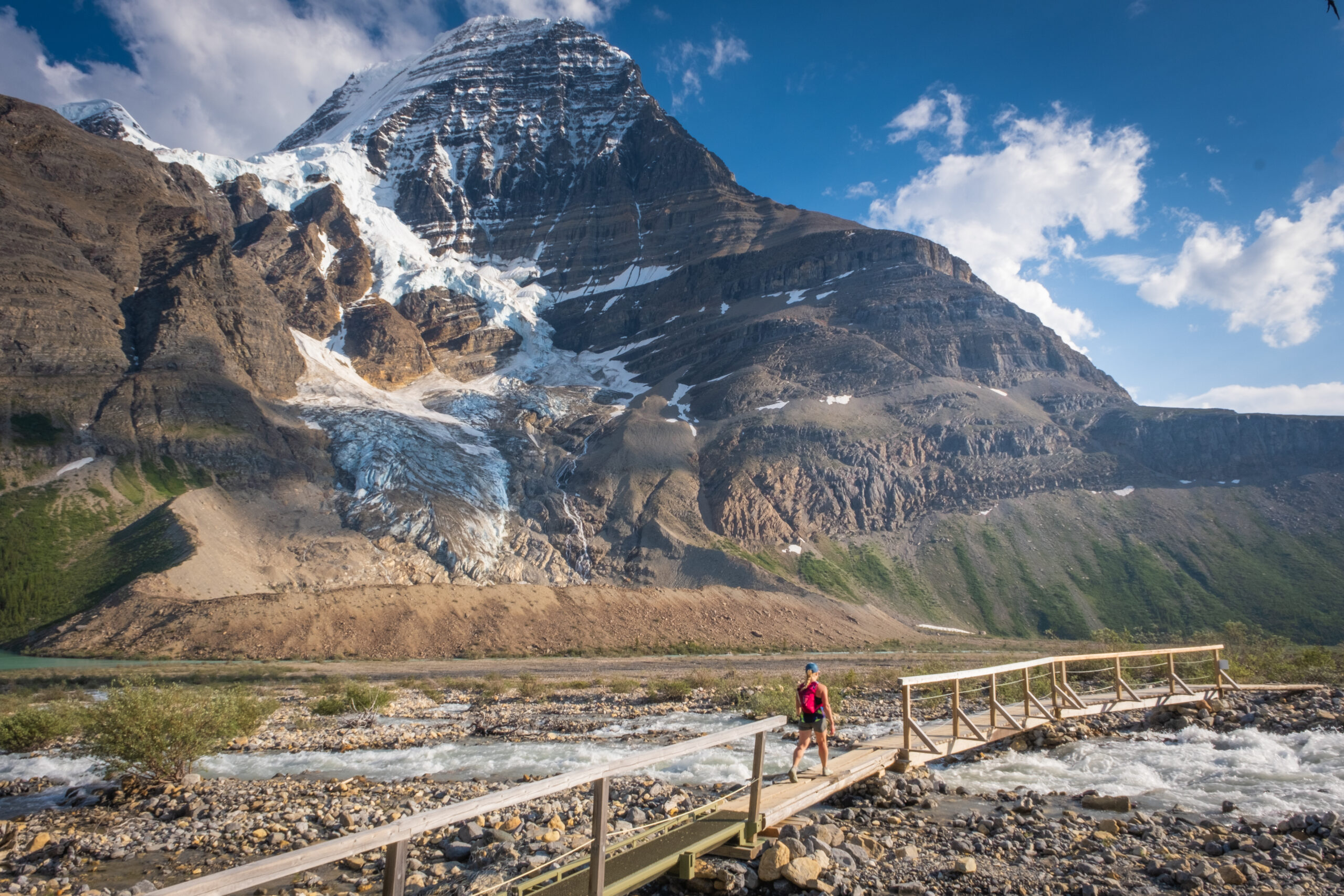
Anyone who has walked into an Arc’teryx or Fjallraven store knows that the price tags on quality gear can be eye-watering. However, the investment can often pay off in performance and longevity. Cheap items often have a shorter life and thus end up in the landfill sooner. If you think you’ll be hiking and getting outside often, the environmentally conscious approach is to purchase quality goods.
The goal is to have gear that will last for years and thousands of miles instead of cheap stuff on Amazon that could get a hole in it after one use. If you’re on a budget, check out your local sporting goods consignment store. In Canmore, Switching Gear is a great consignment store that offers lower prices on quality goods from reputable, well-known brands.
Do You Really Need New Hiking Clothes?

Think about how much time you will spend in the mountains and whether you really need new stuff. The short answer is likely NO. You probably already have a lot of this stuff at home. Wool socks, underwear, and sunglasses are all things I imagine everyone in the closet.
I’ve added recommendations on what we currently use during hikes. Of course, there are hundreds of comparable products. We’ve tried to balance all quality gear for performance and value. I recommend several vital fundamentals, like a decent shell/rain jacket and comfortable boots/shoes.
What to Wear Hiking Checklist
| Sunglasses | Pants/Shorts |
| Hat | Footwear |
| Underwear | Daypack |
| Socks | Water |
| Performance Shirt | Food (+Extra Snacks) |
| Mid Layer | Headlamp |
| Shell Jacket | Base Layer (*Winter) |
| Down Jacket | Gloves (*Winter & Fall) |
Sunglasses
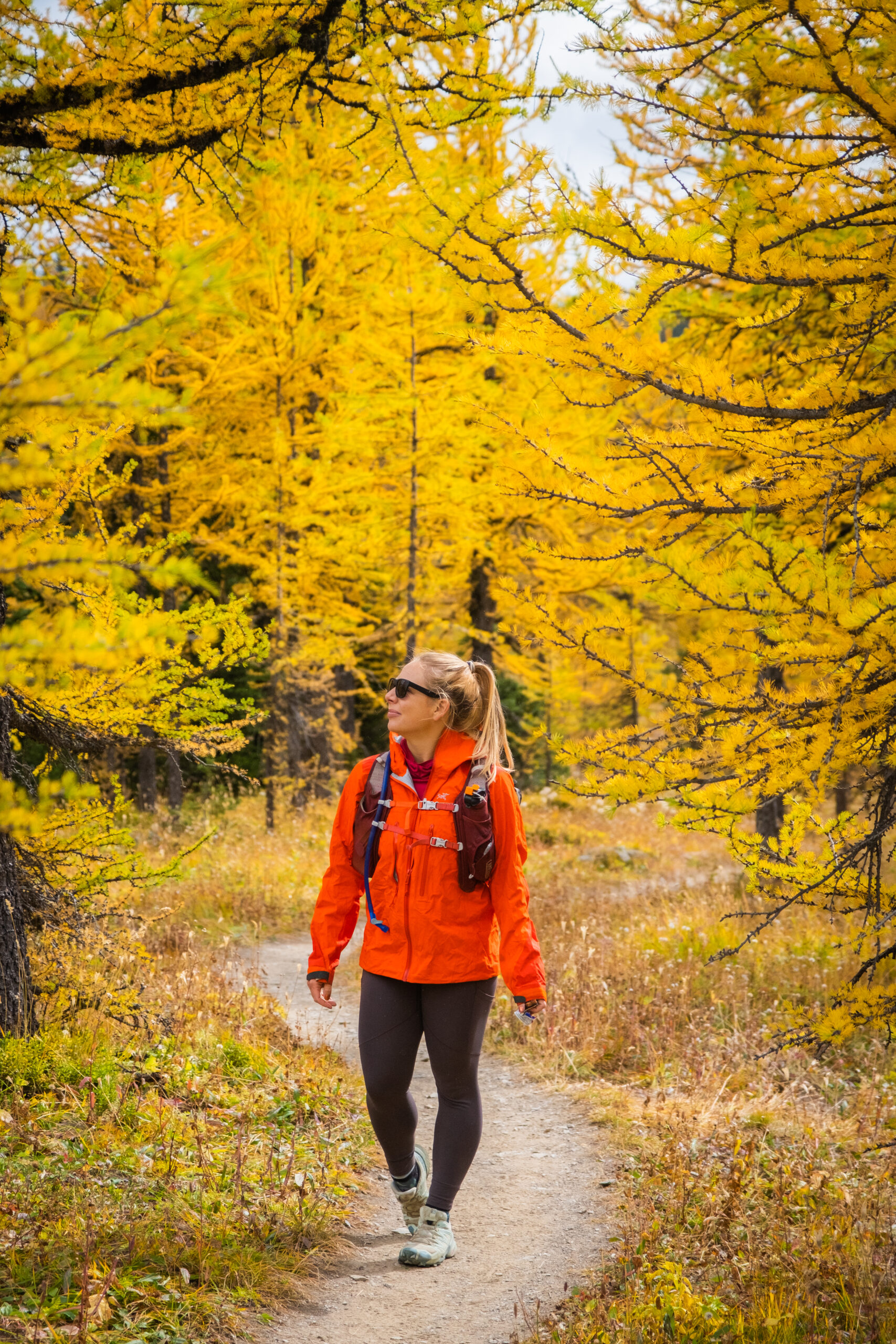
Ensure you protect your eyes from the sun. Since hiking is an outdoor activity, wearing UV protection is essential. UV strength is increased when you’re at elevation or near reflective surfaces such as water or snow. This is important at high altitudes with sparse vegetation and intense UV rays.
A hike up a pass in the Canadian Rockies can easily leave you sunburned and your eyes strained. There are many options for sunglasses, and everyone should own at least a pair. Our favorites for hiking are the Smith Guide’s Choice and Lowdown 2 because the sunglasses have a broad frame to reduce UV reflection.
Hat
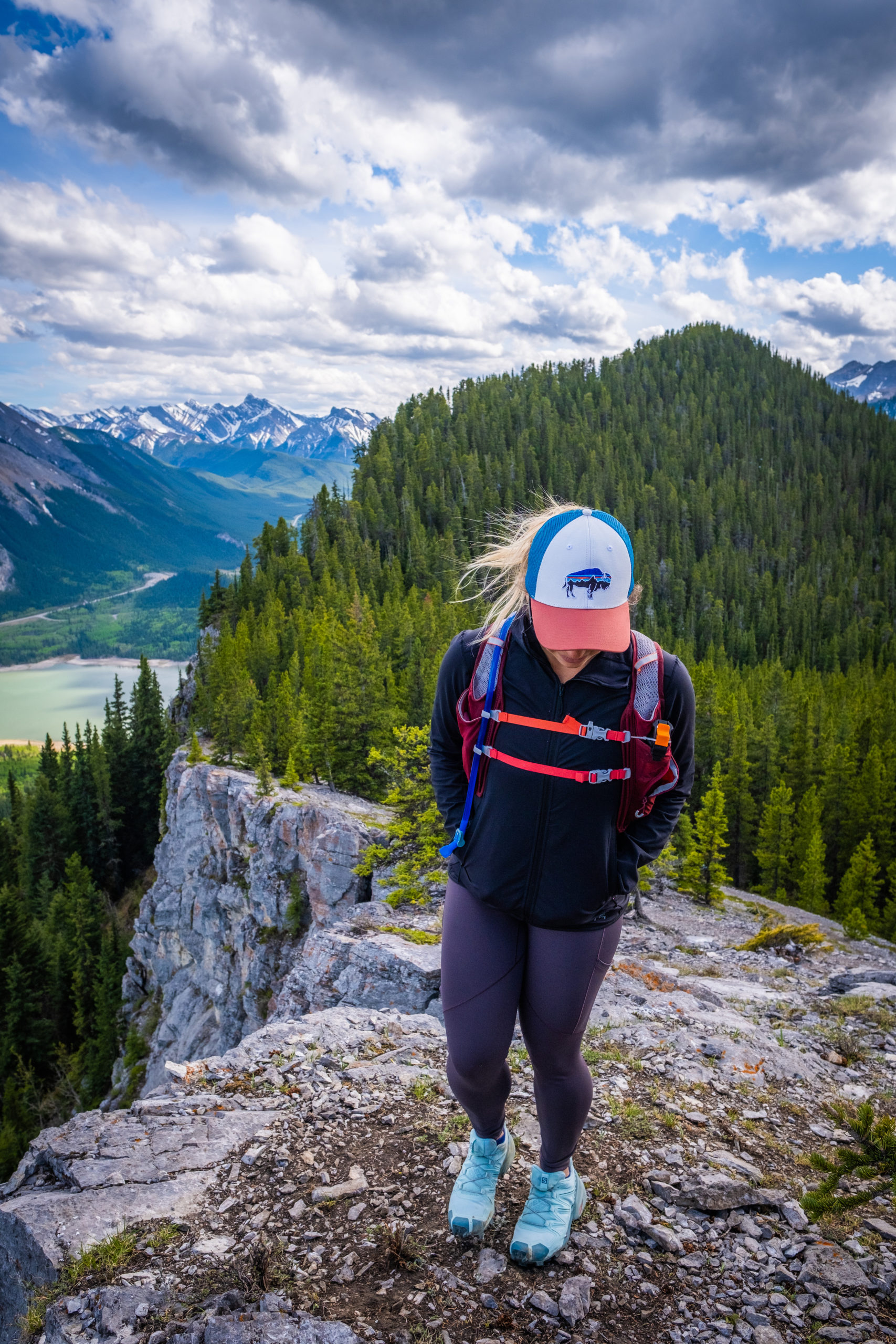
You should pack at least one type of hat to give an added layer of sun protection. We commonly use a ball cap, but a well-designed sunhat with a wide brim is more effective. It’s all a matter of personal preference.
On a sunny day, you’ll see a lot of sun on the trail, so it’s important to protect yourself. Our favorite hats are the LoPro Trucker from Patagonia and the Lululemon Ponytail hat if you want to wear a high pony.
Sports Underwear
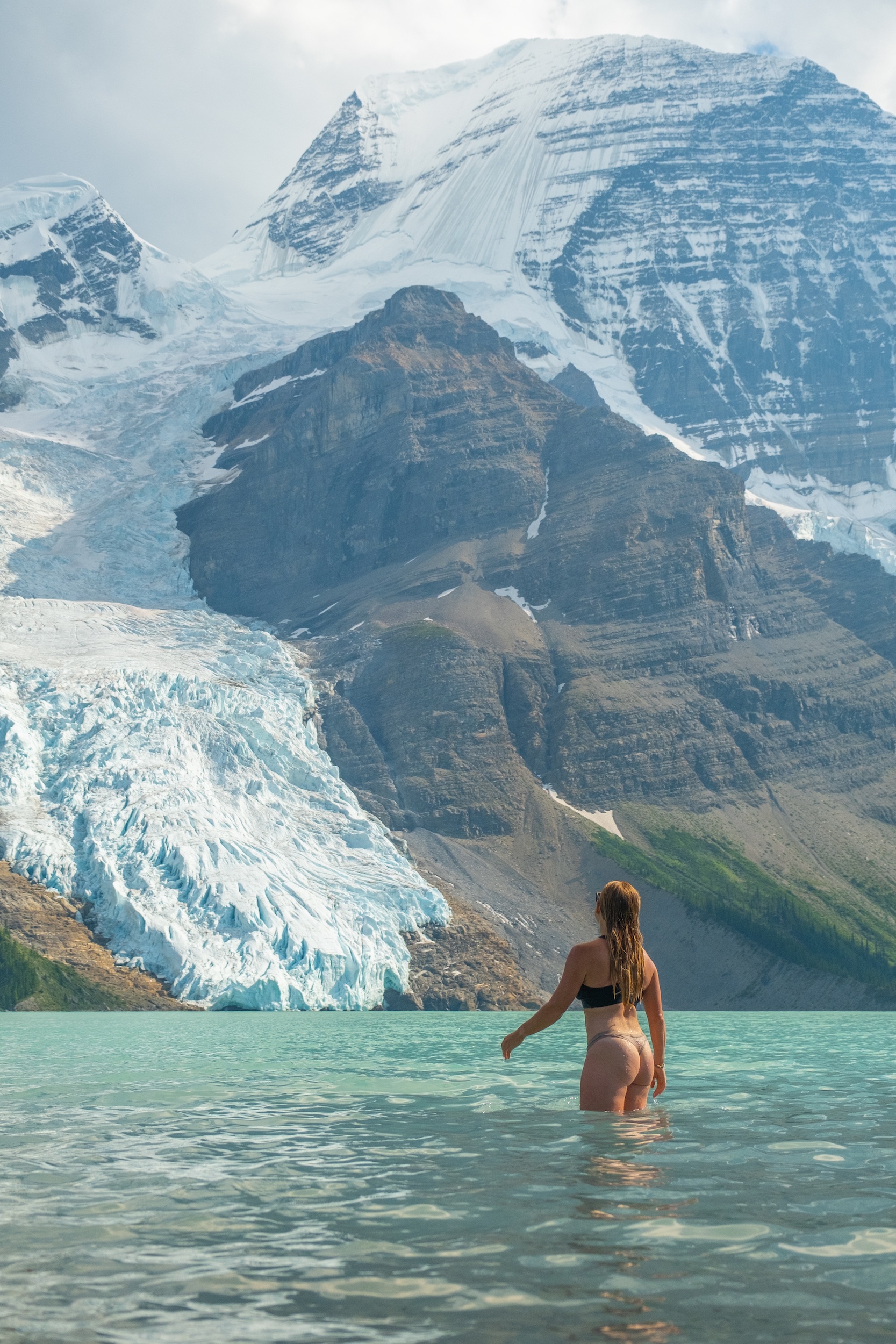
It’s best to wear underwear that wicks away moisture from your body for multiple reasons. The first is that moisture pulls away heat from your body when you’re in cold temperatures. However, more importantly, it keeps you dry in hot weather and reduces the risk of chafing or discomfort.
Chafing might sound a little comical, but it’s a real risk when the distance adds up — just ask any endurance athlete. We both wear wool performance underwear from Icebreaker. The men’s Anatomica and women’s Siren come in various cuts to match your preference.
Wool Socks
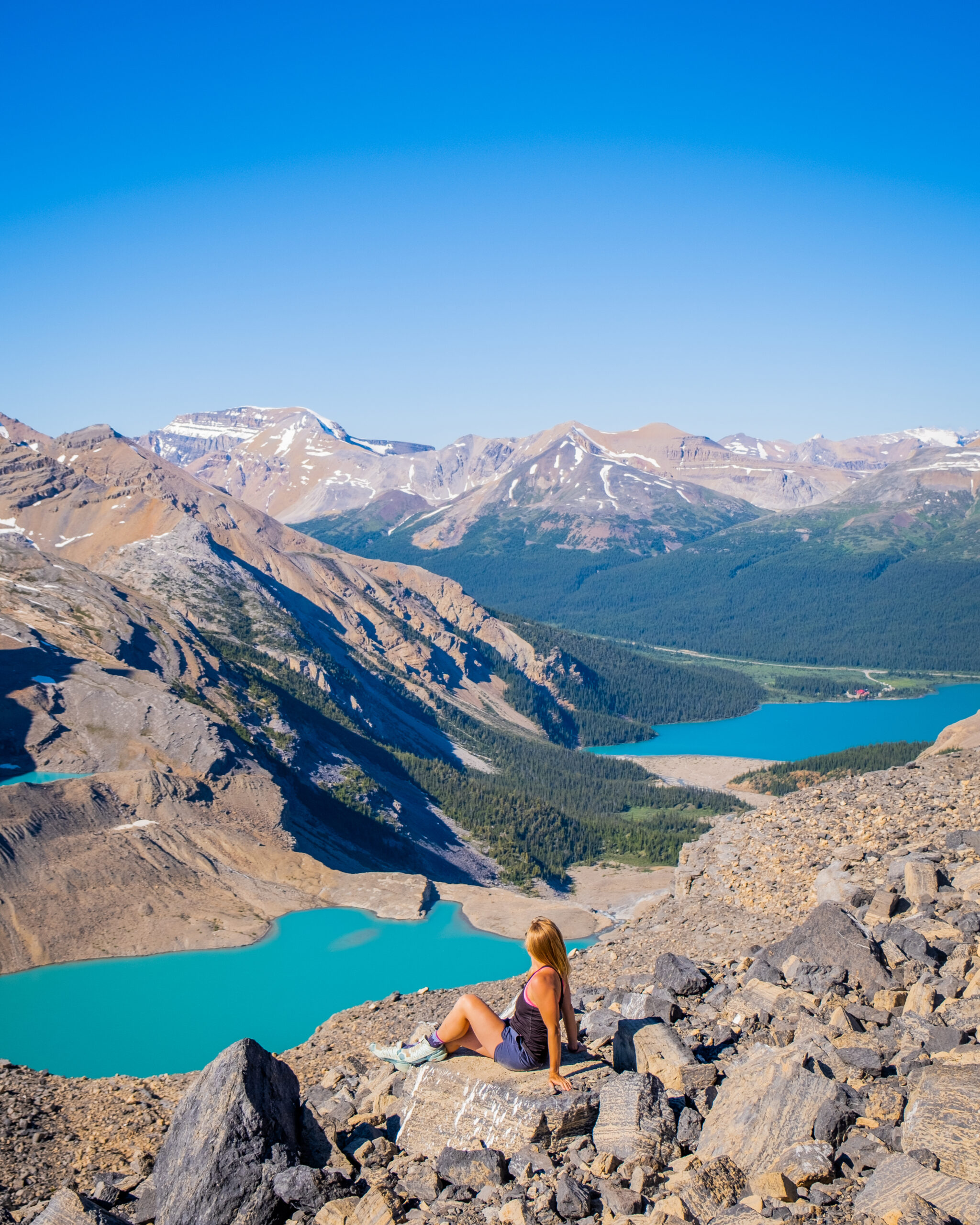
We’ve learned to love our feet with a good pair of socks. Happy feet are dry feet, and the key to dry feet is similar to hiking shirts. Avoid cotton socks, as they cause blisters since they slip, rub, and hold moisture. This is why wool has been the classic choice for socks. Our favorite socks for hiking are from Darn Tough. Another great recommendation for socks is Smartwool!
Performance Shirt
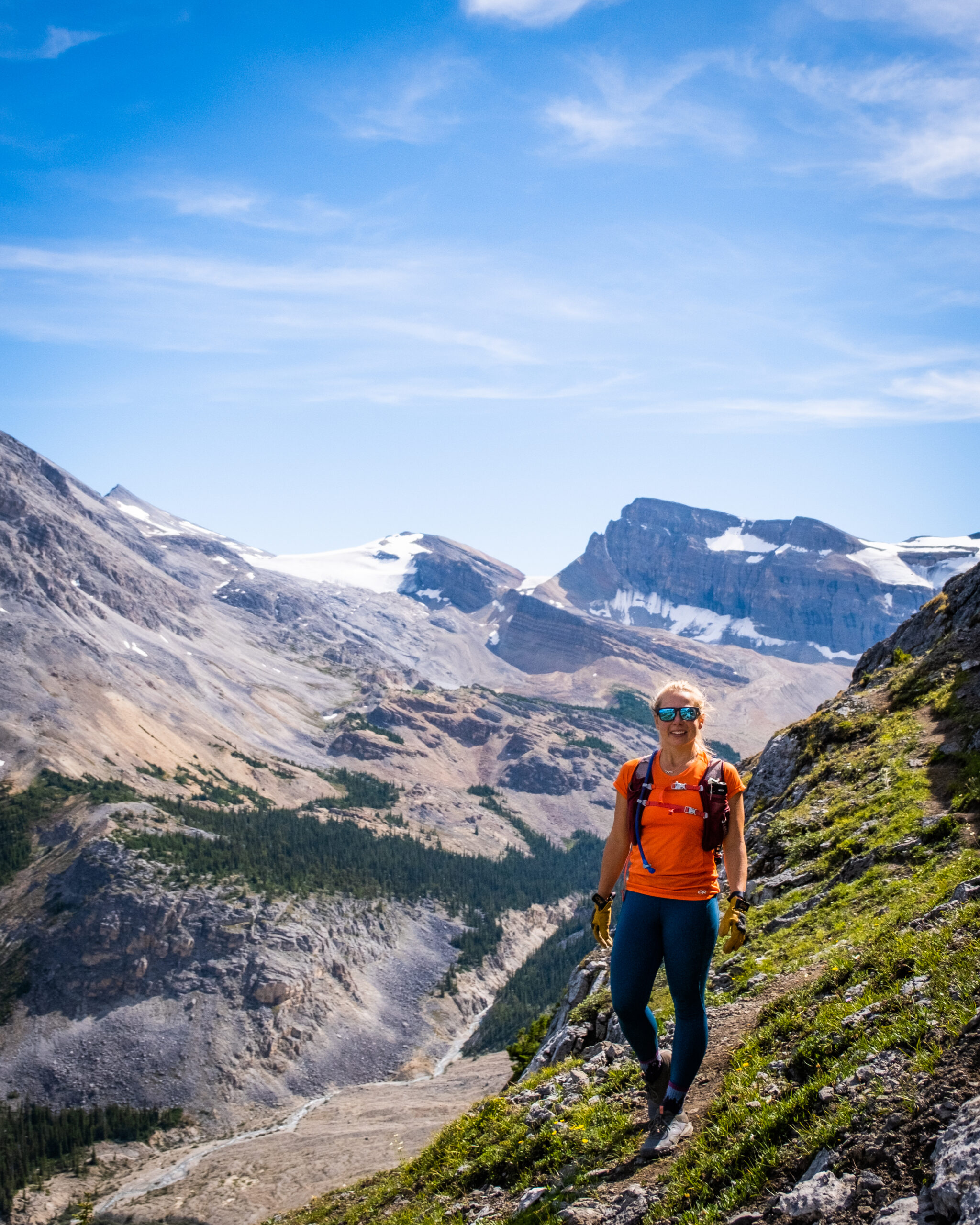
I love to wear a comfortable shirt made from performance fabric that handles sweat on hot days. You should look for a fabric that is lightweight, breathable, and quick-drying, such as merino wool, nylon, or polyester.
We’ve tried a ton of hiking shirts, but we think the Outdoor Research Echo Shirts are a great value. They have long-sleeve, short-sleeve, and tank top options, but I wear long-sleeve shirts more these days for added UV protection.
If you’re unsure about synthetics, try a wool-based shirt from a company like Unbound. They’re more comfortable than synthetic shirts and perform equally well. The only negative aspect of wool shirts is their price.
Mid Layer
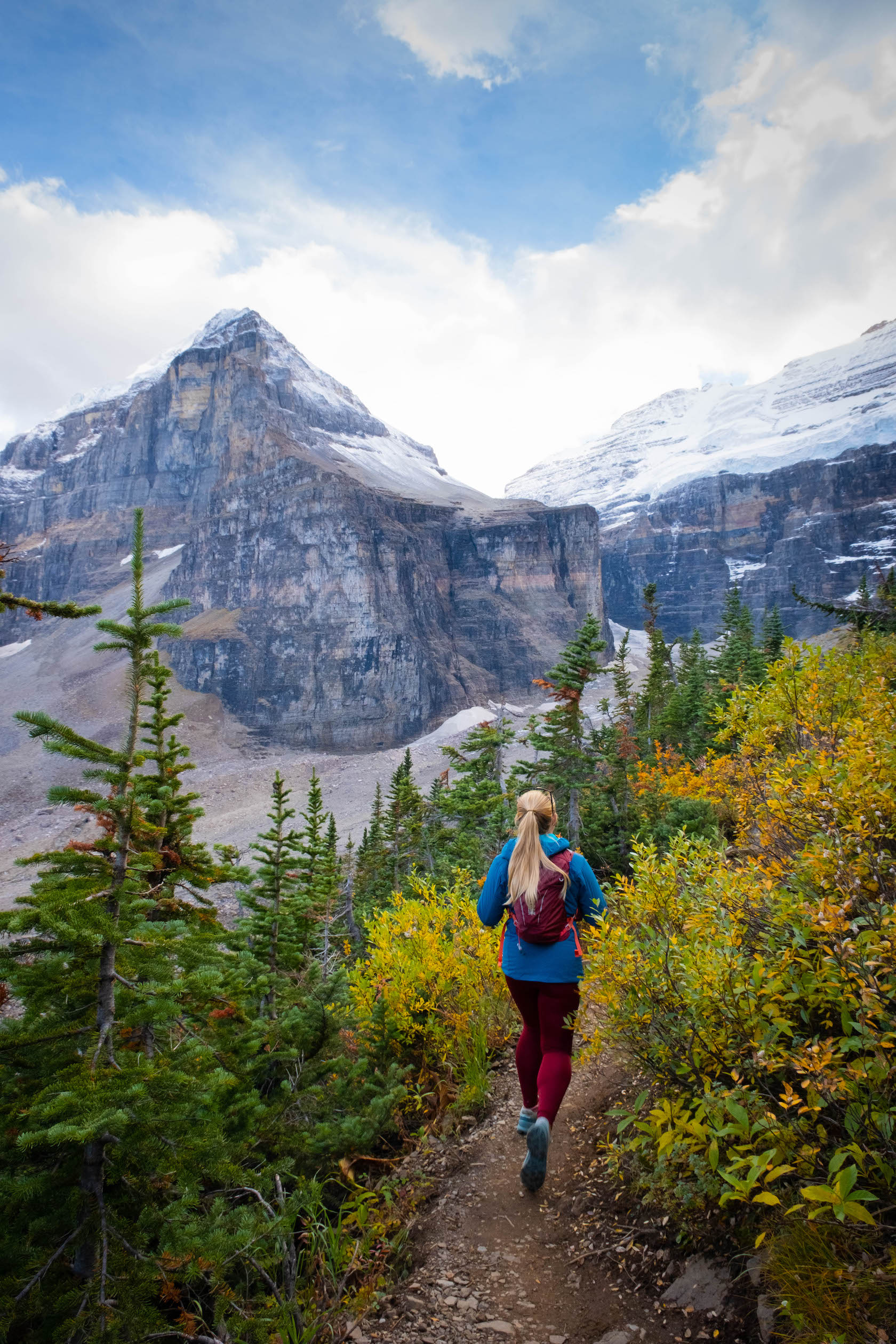
On the trails, you often come across cold temperatures in the mountains. A comfortable sweater is a great way to remain warm in the mornings and evenings. There are a couple of options for hiking mid-layers. You can choose from a fleece, thermal, down jacket, or softshell jacket. It depends on what you find comfortable and the weather on the trail.
A versatile sweater like the Patagonia Better Sweaters is perfect. It’s a slim-cut fleece with a soft lining that moves well with your body, while the outer material feels tough and shows little to no wear. However, there are many options, and there is rarely a wrong choice. You’ll likely see a ton of locals wearing the Arc’teryx Atom, as it’s a popular synthetic down jacket.
Down Jacket
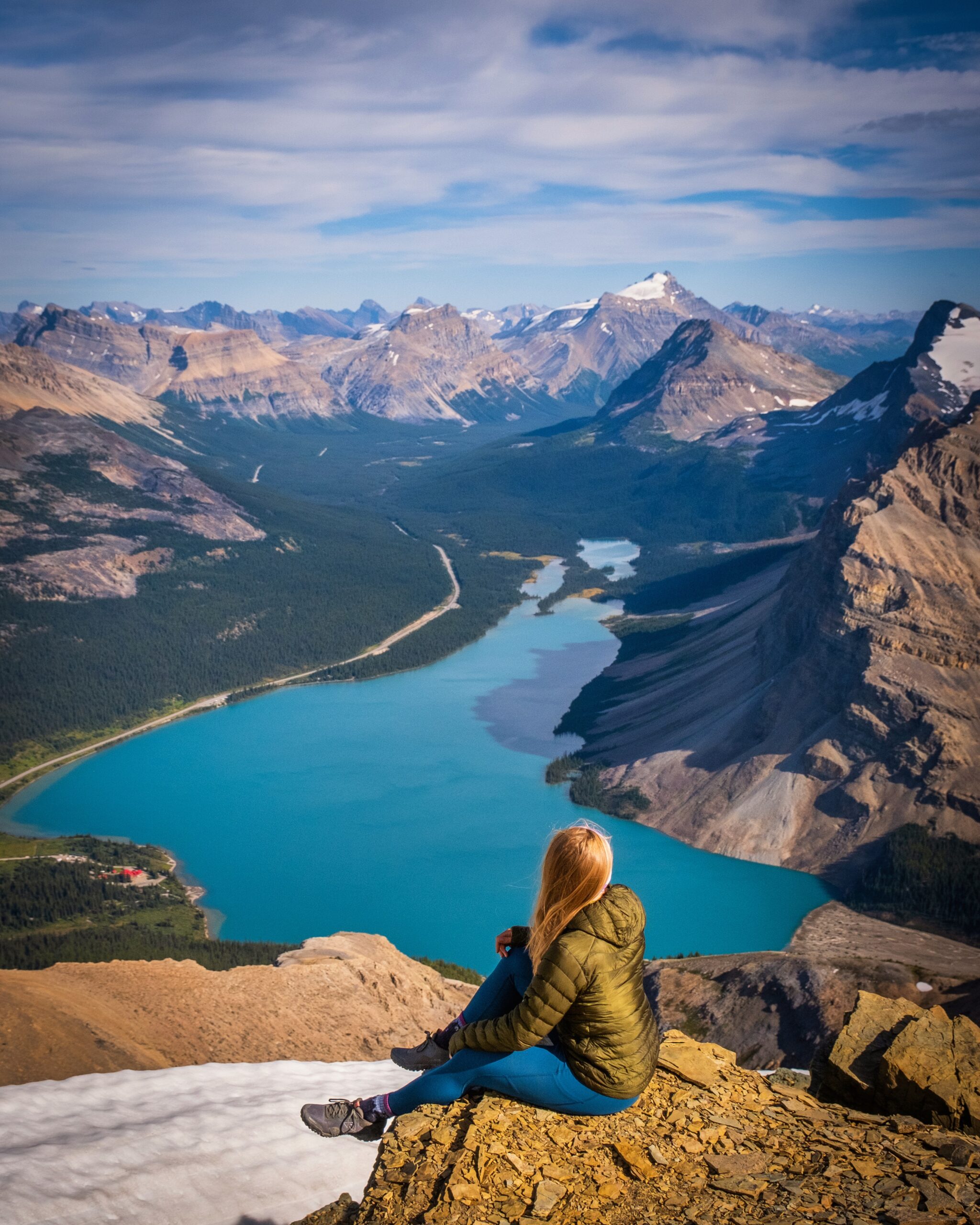
A packable down jacket is an outdoor staple for every hiker. It’s warm and provides decent protection against wind. It also packs down and fits easily in a backpack. We always recommend bringing a down jacket on almost any hiking trip. It’s a great way to keep warm without eating up too much space in your hiking backpack when dealing with the mountains and vast temperature shifts.
My favorite down jacket is the Arc’teryx Cerium, which blends the perfect balance between lightweight, performance, style, and fit. No matter the month or season, it’s always down jacket season in Banff! They stay hanging in our closets all year. Some other great recommendations for down jackets include the Patagonia Down Sweater and REI Co-op 650 Down.
Shell Jacket
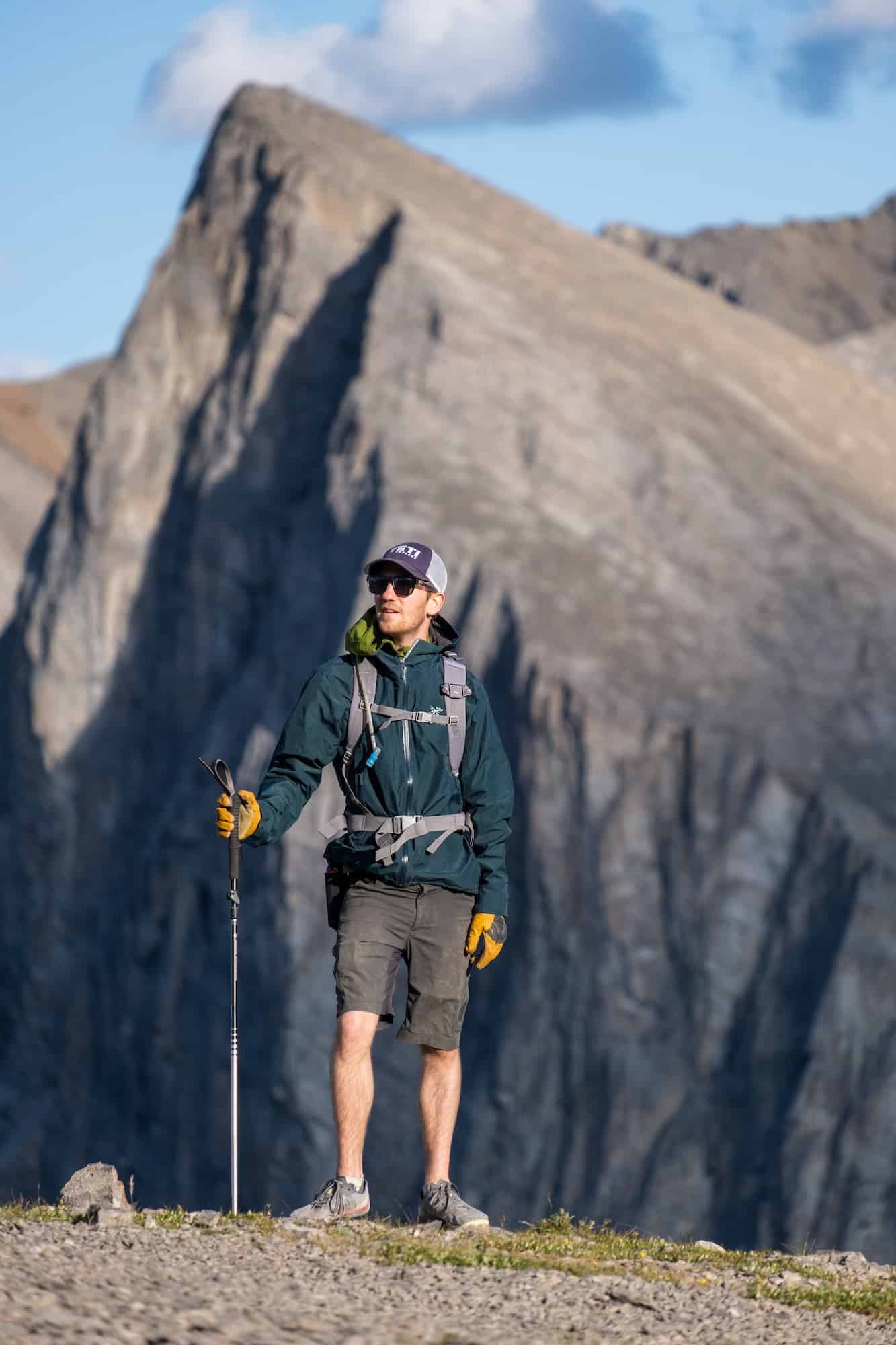
We always recommend hiking and traveling with a shell jacket. They do an exceptional job of protecting you from the elements in the mountains, which could include wind, rain, or snow. We suggest a packable rain jacket for the outdoors/hiking.
Any rain jacket will do, but the top-dollar ones designed for the outdoors will hold up and help in inclement weather. They are lightweight, durable, packable, waterproof, and windproof — the wind may be the most important as it can be unrelenting.
A lightweight windbreaker is great for warmer days when the chance for rain looks unlikely. It can help you in a pinch against a surprise shower, chill, or even hordes of insects. A light windbreaker also packs down small and fits easily in a backpack. We both love the Arc’teryx Squamish Hoody for this purpose.
Shell jacket recommendations:
Hiking Shorts
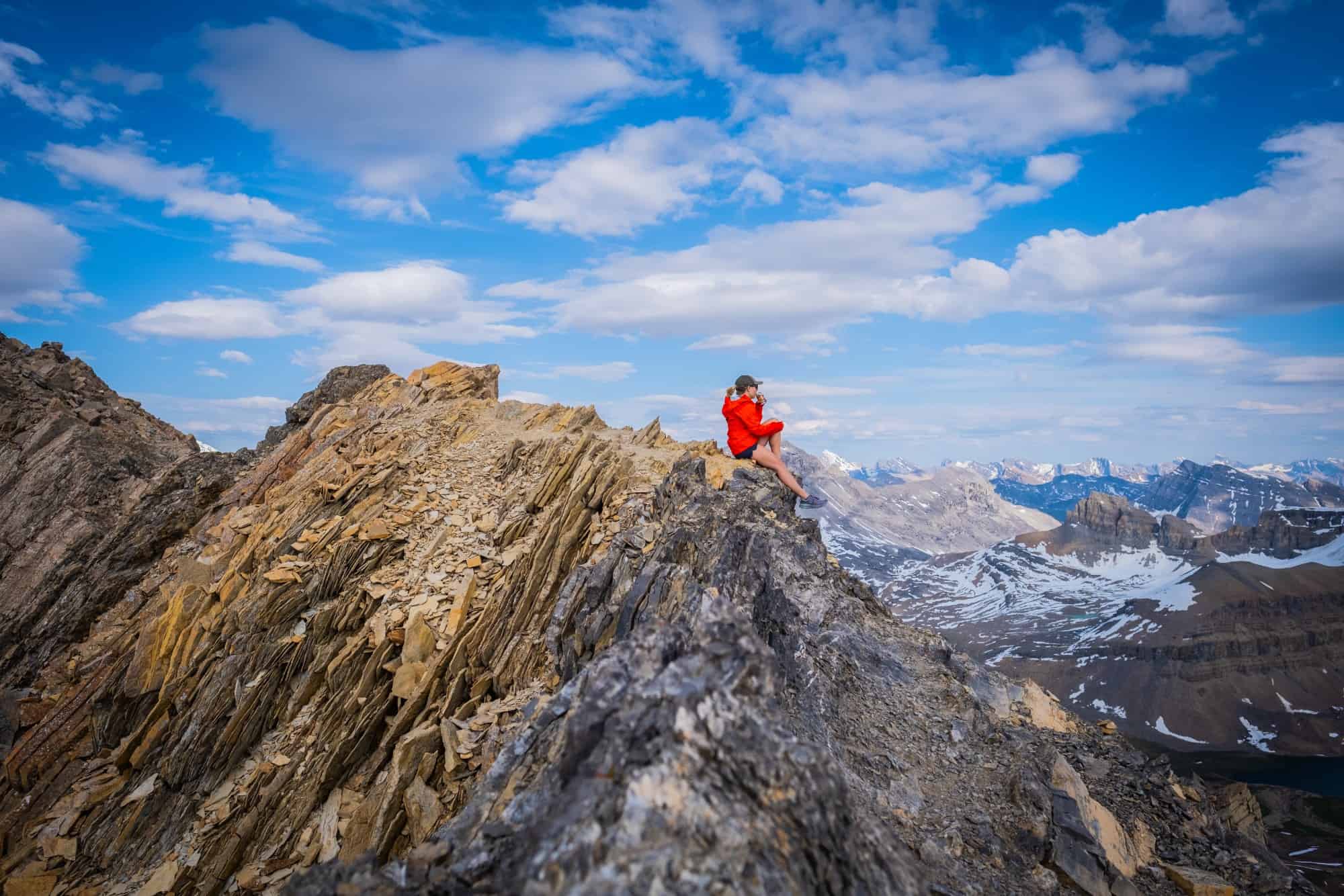
Even with the mountains’ unpredictable weather, you’ll find us both in shorts on most hikes. We prefer to take the approach of fast and light for our clothing. I find heavy, “traditional” hiking shorts with endless pockets unnecessary and uncomfortable.
Shorts and pockets put pressure on your thighs when hiking up a hill, and they’re redundant to a backpack or vest for storage. Running shorts are far more comfortable. I’ve tried several running shorts, with several wins and misses.
We both love a lined short as it reduces the risk of chafing, but the key is that the liner needs to be brief vs. a bikini cut. Men can check out the REI Co-op Swiftland 7″ Running Shorts & Lululemon Fast & Free Shorts. Natasha loves the Lululemon Hotty Hot Shorts.
Hiking Pants
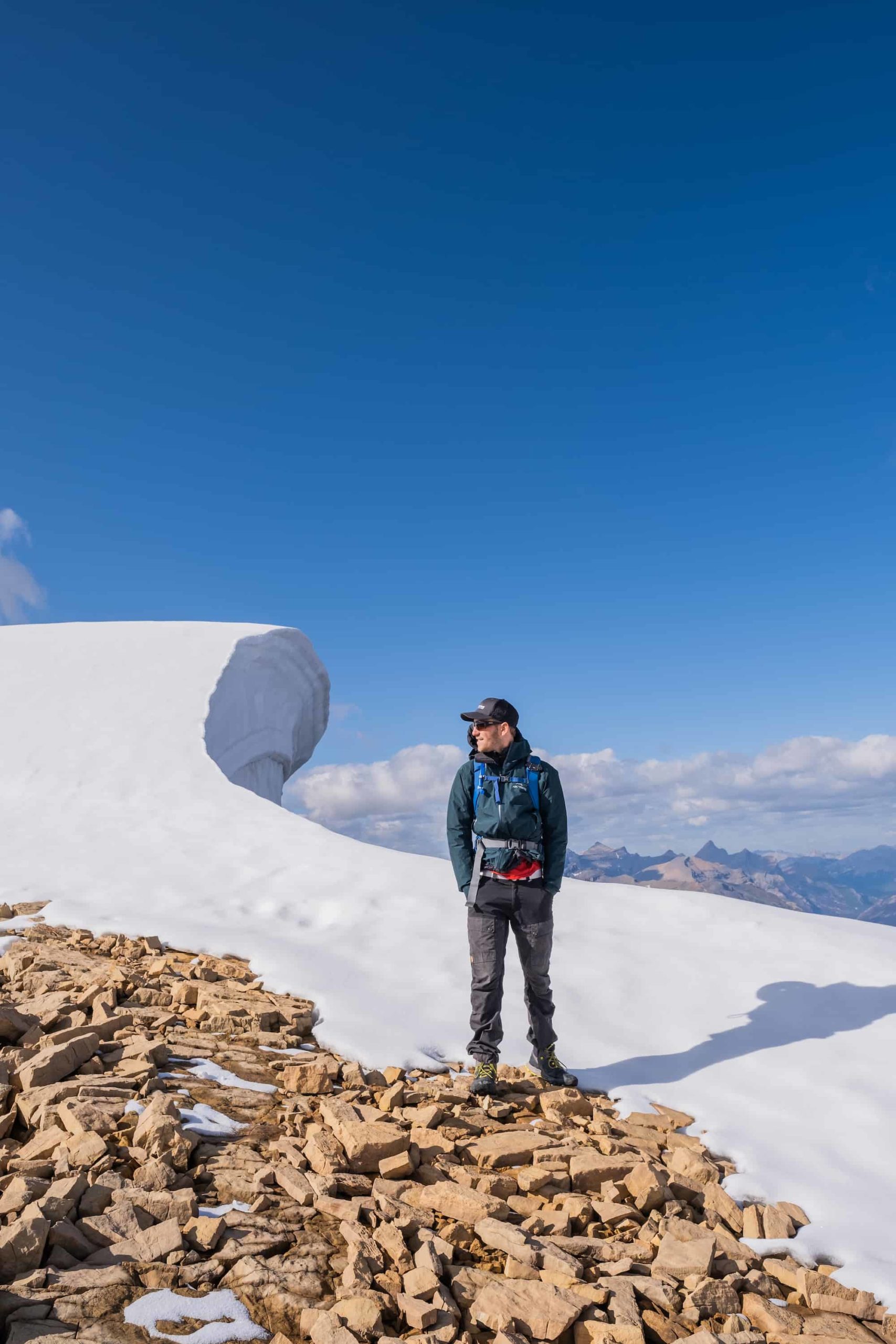
Lightweight synthetic pants are tremendously useful to have in your pack. We wear them most days when hiking because they’re comfortable, antibacterial, and protect our legs from mosquitos and branches.
For most, we suggest some technical pants made from synthetic material. We love many new hiking pants that have a casual style appropriate for an evening out and the hiking trail. The Men’s Kuhl Renegade and Women’s Kuhl Freeflex pants are exceptional for travel and hiking, but you’ll also see us in Fjallraven Kebs often.
Hiking Footwear
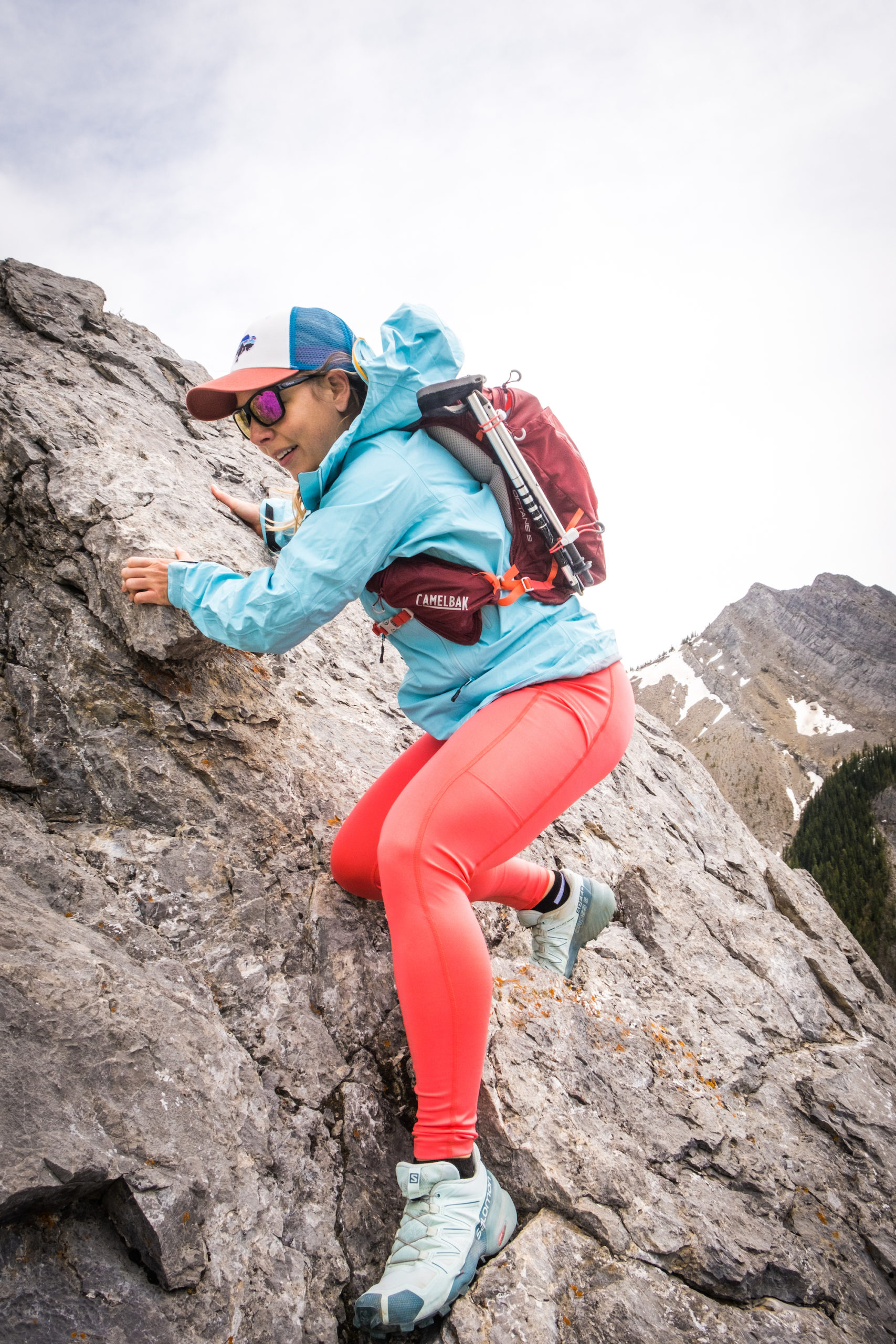
I could write dozens of articles on the best shoes for hiking. Truthfully, there are a ton of variables when it comes to footwear. Things to consider are terrain, fit, style, and intended use. I have several different options for footwear for the trail, and I choose based on the day.
Choose a shoe that best fits your everyday needs. A trail running shoe is perfect for most hikers as it works both on and off the trail. That way, you get plenty of use out of your investment. Low elevation and easy hikes in Banff are on well-maintained trails, so a good pair of hiking or tennis shoes is more than adequate. If you need extra support, do not hesitate to choose the best option for yourself.
There has been a long debate about whether you need high-top boots or low-cut shoes to protect your ankles. Truthfully, we own both types and like to wear high-tops on muddy trails or areas with thick vegetation and shoes in warm and dry weather. The stiff sole in boots helps carry weight on multi-day camping trips.
Trail Running Shoes
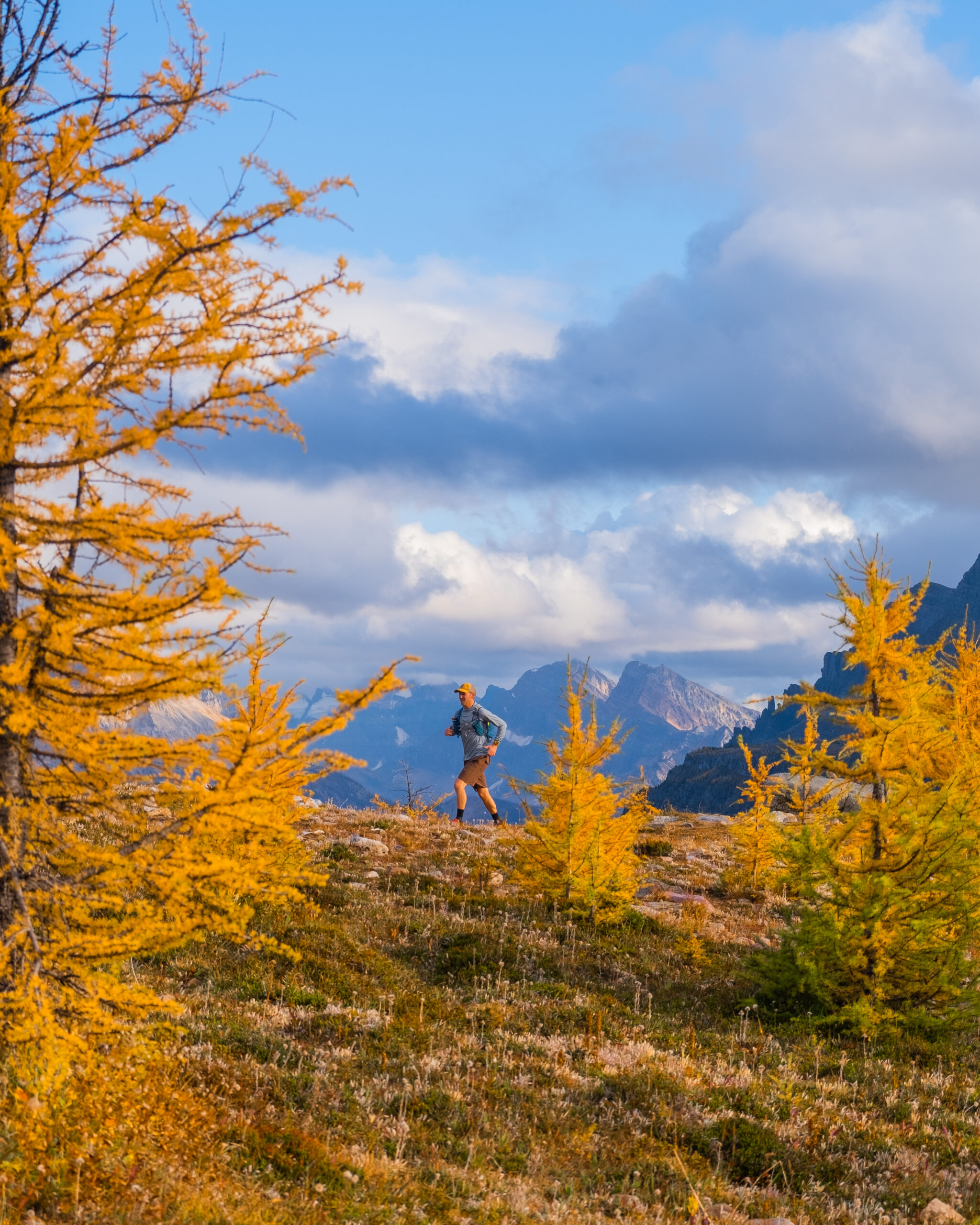
We personally both have numerous pairs of Salomon Speedcross trail runners, and they’re great on the trails. They have a diehard following in the Rockies, and for good reason. The lightweight shoe is high on comfort, and the aggressive tread pattern ensures you always have a grip. We’ll burn through a pair of these each summer.
However, the shoe is limited in its use if you’re not a regular hiker or trail runner. If you want a more versatile shoe, I like to run around my local trails and streets in the Hoka Speedgoat. As I stated earlier, Banff’s low elevation and easy hikes are on well-maintained trails, so a good pair of hiking or tennis shoes is more than adequate.
We mix it up, but if you plan to take big mountain hikes/scrambles, PLEASE wear hiking-specific shoes or boots. Too often, people get in trouble with the wrong footwear on a trail where a slip could mean serious injury or death.
Hiking Boots
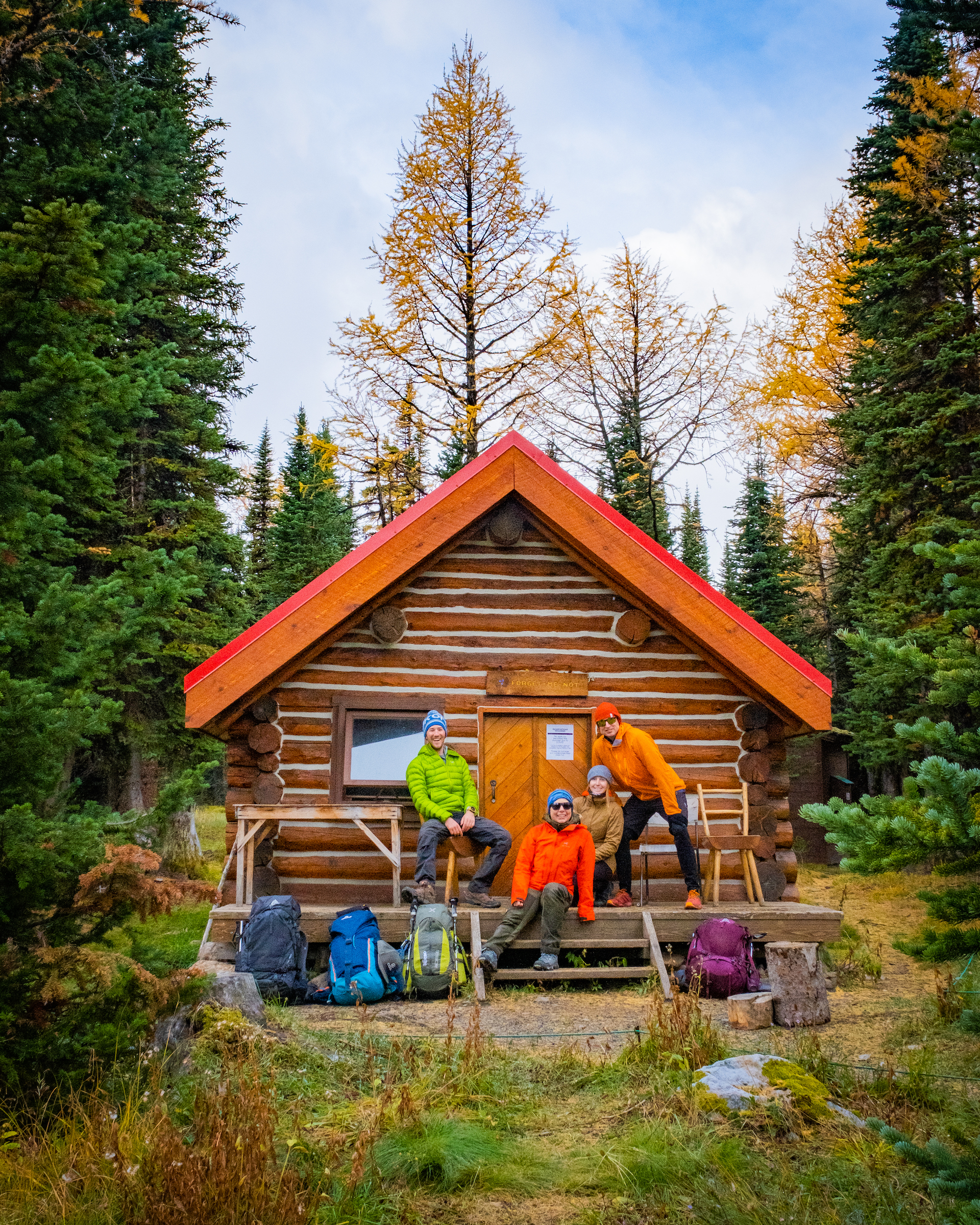
Not everyone needs hiking boots while hiking in the Rockies, especially on simple and easier terrain. We personally only use them in the off season or on multi day treks.
Though it’s tough to beat purpose-built synthetic boots, as they are lightweight, breathable, quick-drying, and often waterproof. Ankle-high boots protect against thick brush, bugs, and loose rock that we can encounter. A good pair of hiking boots is useful for exploring different climates, like in winter in the Rockies.
We love the Merrell Moab, which comes in high and low-cut versions. They are not the most technical boots, but they are always reliable and never give you a blister. I took a brand new pair on a backpacking trip and hiked 30 kilometers a day in them with no threat of blisters. Most importantly, they’re the best value for hiking boots! If you feel you need some extra arch support with hiking boots, it’s best to get a pair of insoles.
Daypack
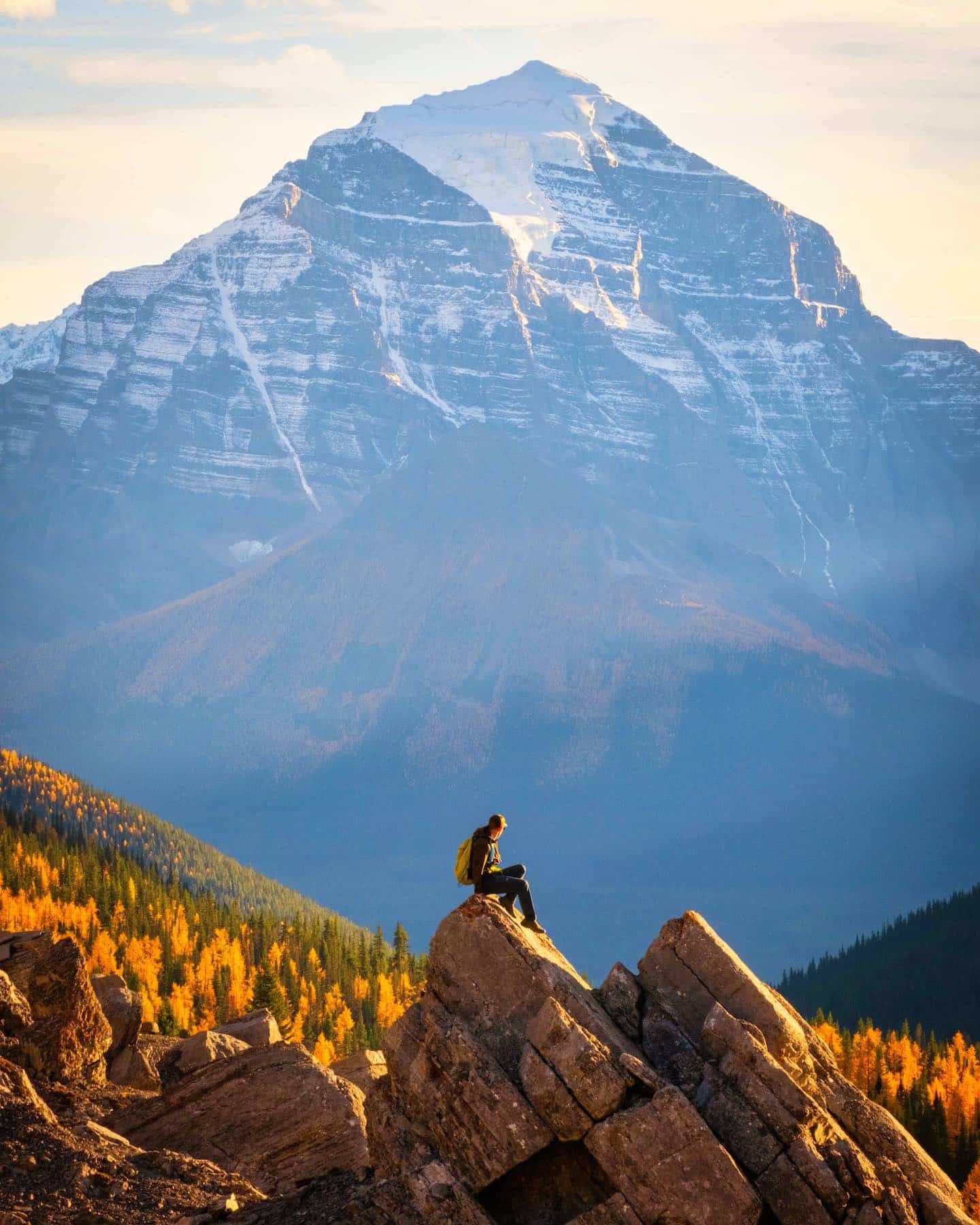
A daypack should be enough to hold your belongings if you’re not going on an overnight backpacking adventure. No matter what you do in Banff, you will want a daypack to store your belongings. My daypack usually consists of a shell jacket, down jacket, hiking poles, bear spray, food, water, gloves, chapstick, sunscreen, headlamp, camera, first aid kit, navigation, and an emergency blanket.
While not everyone needs an alpine pack, the key to take away is to opt for the correct size pack. I love a versatile size around the 30L mark. 30L gives enough room for gear-heavy days, but it’s light enough for short treks or walking around town. If you don’t have plans for big hikes, any nice backpack will do the job. A reliable daypack is the Osprey Tempest and Talon.
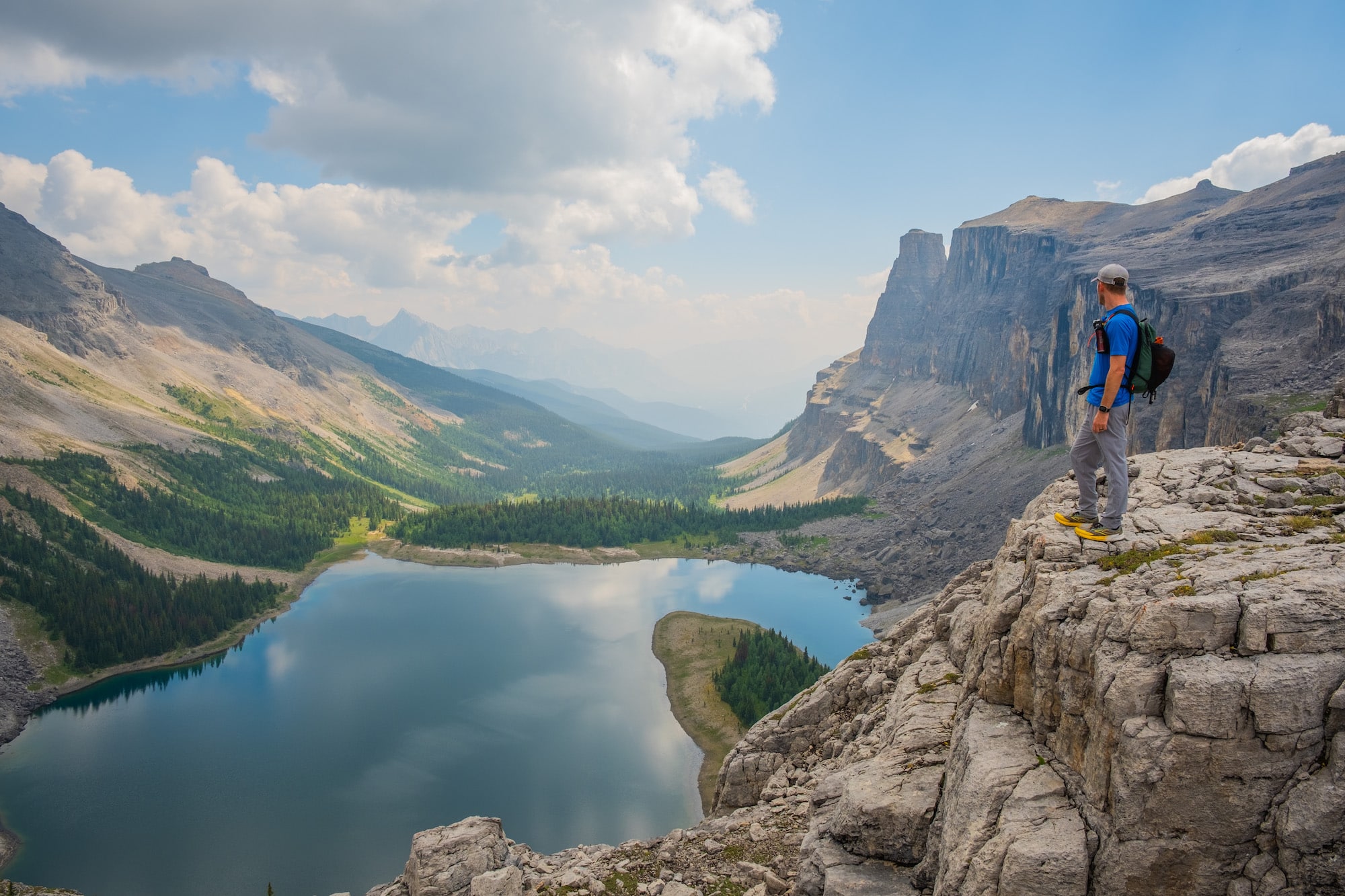
When we’re on shorter hikes or trying to pack ultralight, our go-to daypack is the Mammut Aenergy. The Aenergy allows us to pack all we need in under 15L, allowing us to move faster and sometimes run on the trail. It has wide shoulder straps and reflective details. If you plan on trail running or enjoying the Mount Norquay Via Ferrata, this is a fantastic all-mountain pack!
Thermal Layers
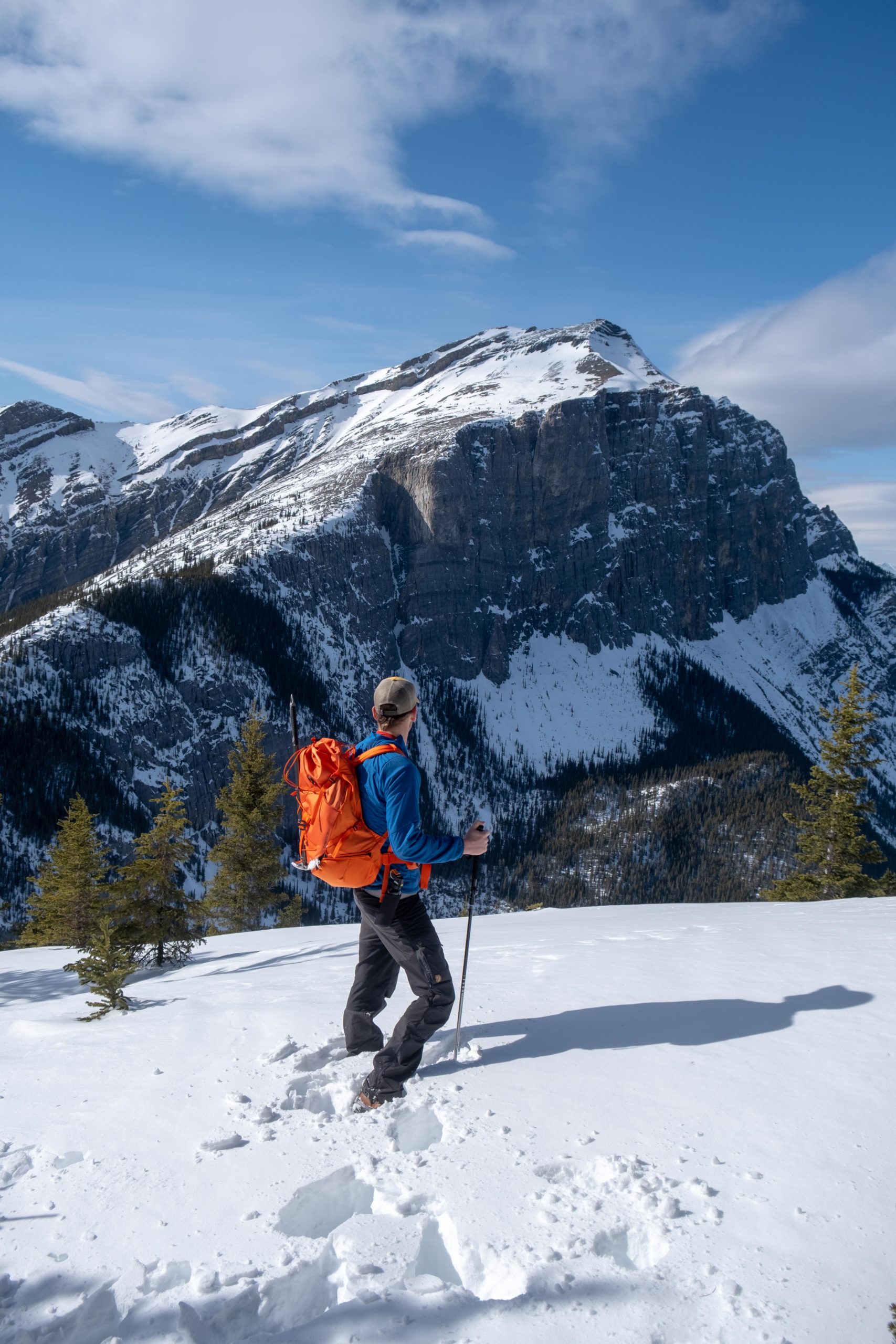
This is really specific to winter hikes and when temperatures drop below freezing. In general, we do not wear thermals if the temperature is above freezing. However, they’re essential if you’re in alpine conditions while hiking, snowboarding, scrambling, or camping.
We recommend base layers that fit snugly and are made from a noncotton material like nylon or wool. We’ve had many base layers, but our favorites are wool base layers from Helly Hansen and Smartwool.
Toque
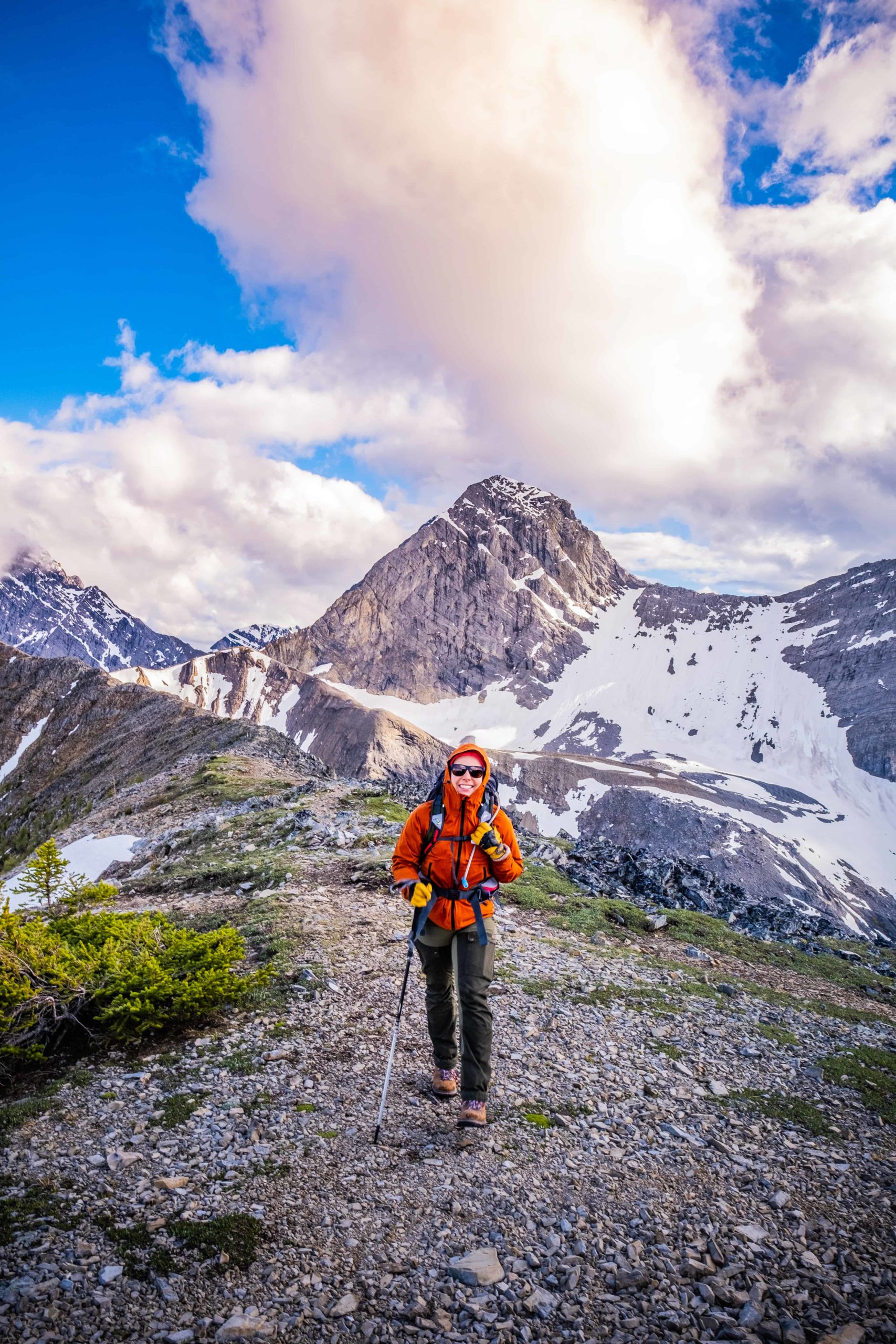
As I’ve said before, cold evenings and nights are frequent at elevation, so a small beanie to keep your head warm is always nice to have in your pack. Covering your ears is one of the best ways to warm up, and it takes up little space in a backpack.
Gloves
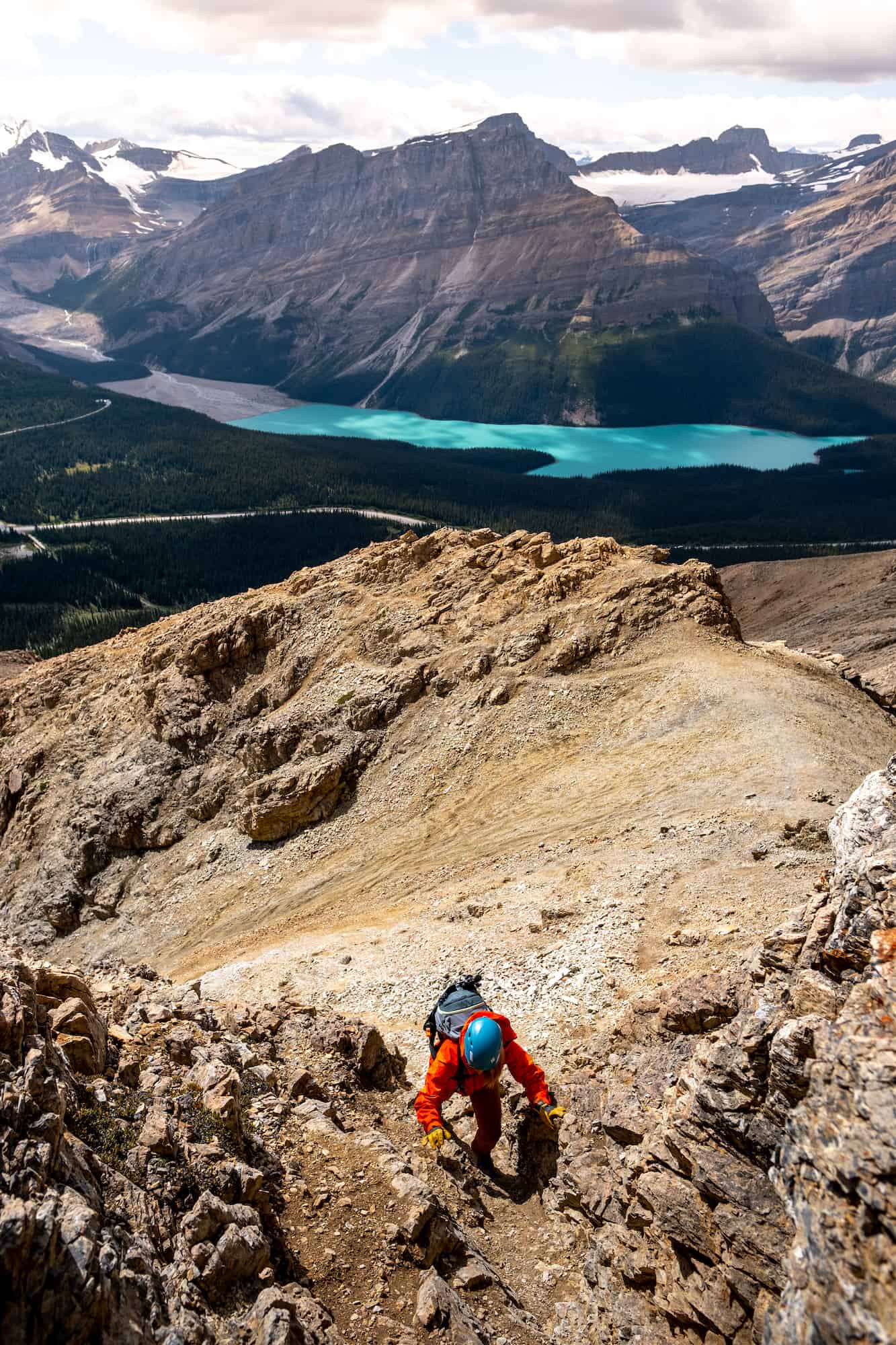
Heavy winter gloves are not necessary on the average hike, but a lightweight pair is great for those prone to cold hands, as it gets quite cold at elevations in Banff. If you’re trekking in cold temperatures, consider a pair of lightweight, weatherproof gloves that protect your hands from the elements. Many gloves are purpose-built for hiking, jogging, or general sports activities that would be great for your trip.
Peak Design Capture Clip
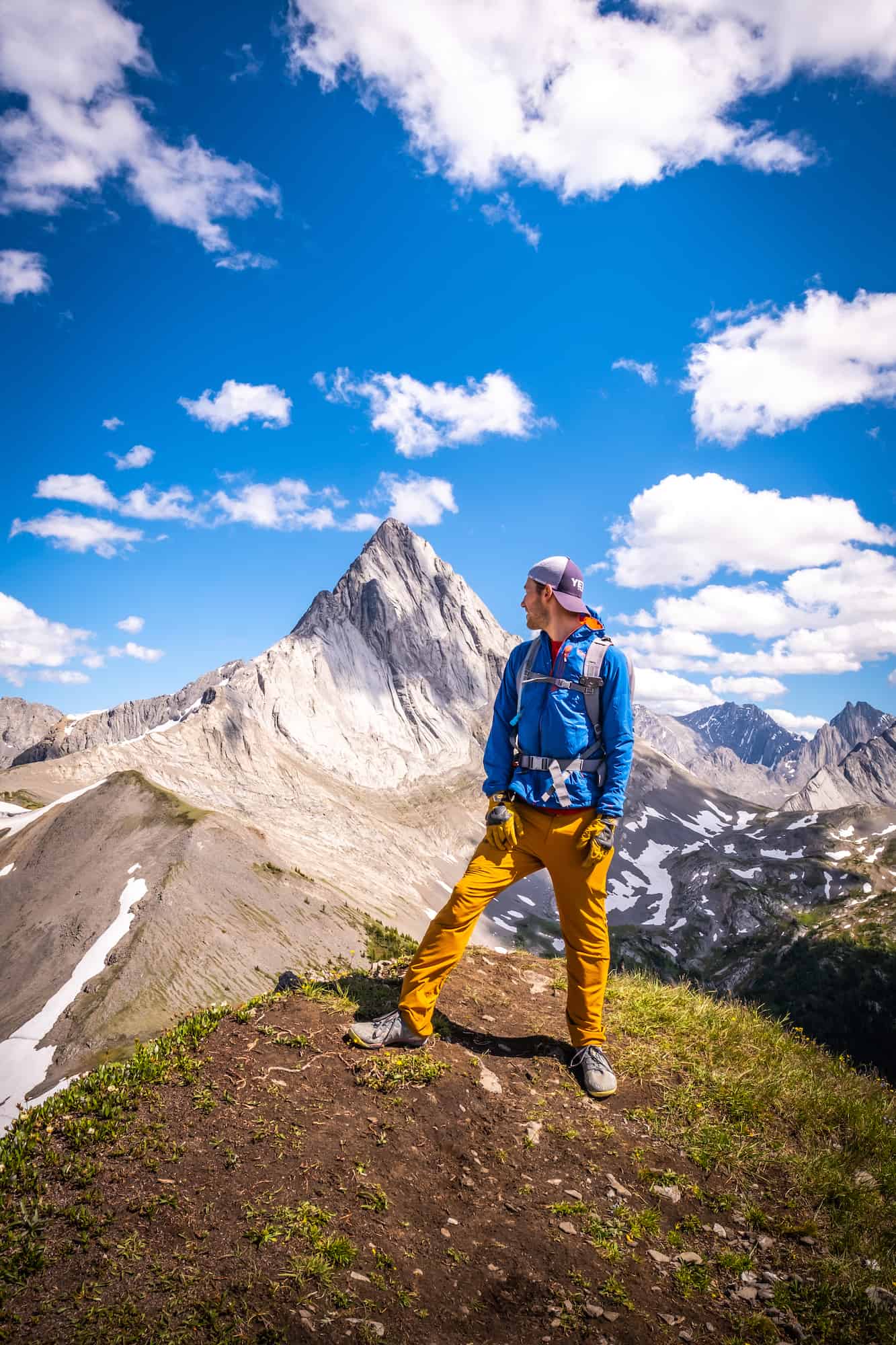
This has been one of our favorite additions to our camera equipment and hiking outfit. The Peak Design Capture Clip allows a camera to be clipped onto your backpack strap or belt. It has to be one of the best accessories we’ve ever used for carrying our camera while hiking in Banff (because you will want to take lots of photos!)
Bear Spray*
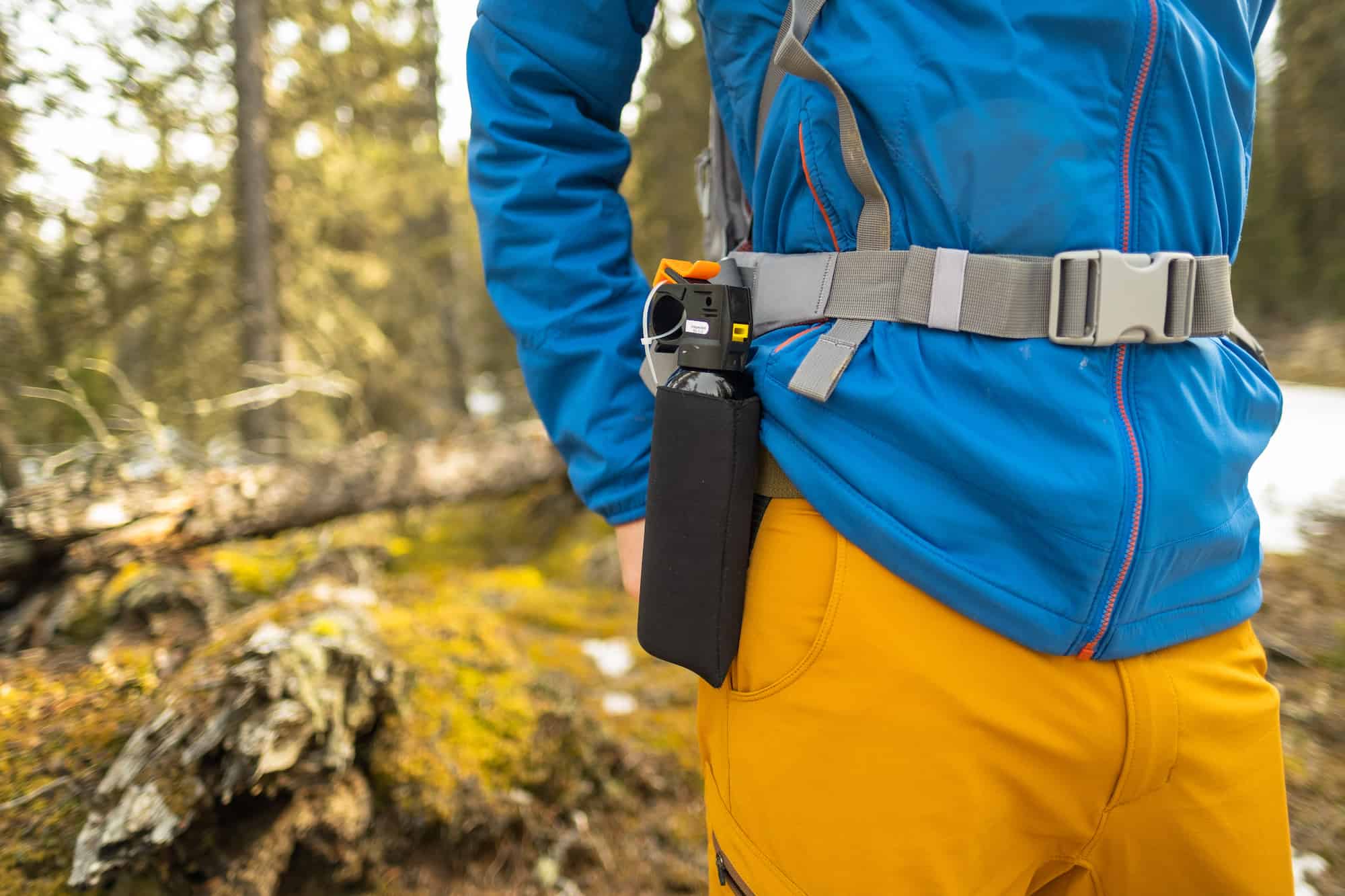
This is a non-negotiable item if you’re in bear country. In some parks, it’s actually required by law. Bear spray should be on your person, not in your pack. We each have a neoprene sleeve that holds our bear spray in our belt pocket. It’s easy to reach in an emergency, which is the most important detail.
It’s a good idea to make noise while hiking in the bear country, whether singing, clapping, or banging your hiking poles. Be wary of blind spots on your hikes, such as tight bends and forested sections of the trail. We have a post with tips for hiking with bears.
Plan Your Trip to the Canadian Rockies
- Recommended Experiences: There are many things to do in the Rockies, but our top recommendation is the Banff Gondola – a must do experience! Want to get up close and personal with a glacier? We cannot recommend this Icewalks tour enough!
- Planning your visit to Moraine Lake and don’t want to deal with the Parks shuttles? We recommend using Moraine Lake Bus Company or booking this Radventures tour!
- Transport to Banff: If you don’t want to drive to Banff, we totally get it. To avoid this book with the Banff Airporter.
- Hotels in the Rockies: There are many places to stay, from luxury hotels to wilderness cabins. See all our favorites here.
- Get Around: We suggest renting a car to get around. You can search for rental cars on Rentalcars.com. For a campervan trip, you can check prices and compare on Outdoorsy.
- We can help you plan your 2025 trip to Western Canada! If you’re feeling overwhelmed by planning we can assist! We’ll PERSONALLY go over your itinerary, hop on a 1 on 1 phone call, or create a bespoke itinerary just for you! See our services here.
↓ Ask Your Questions ↓
The Banff Blog Private Facebook Group is your headquarters for Canadian Rockies travel advice and information, including hike and off-season travel information. You can also meet new adventure buddies.

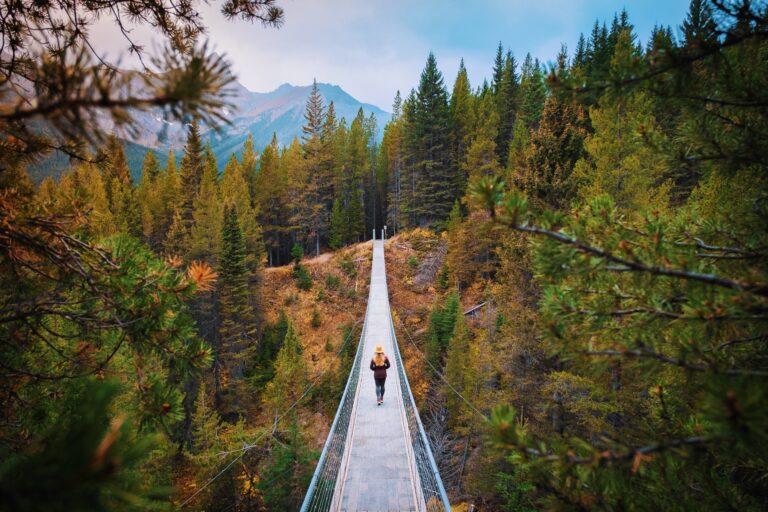
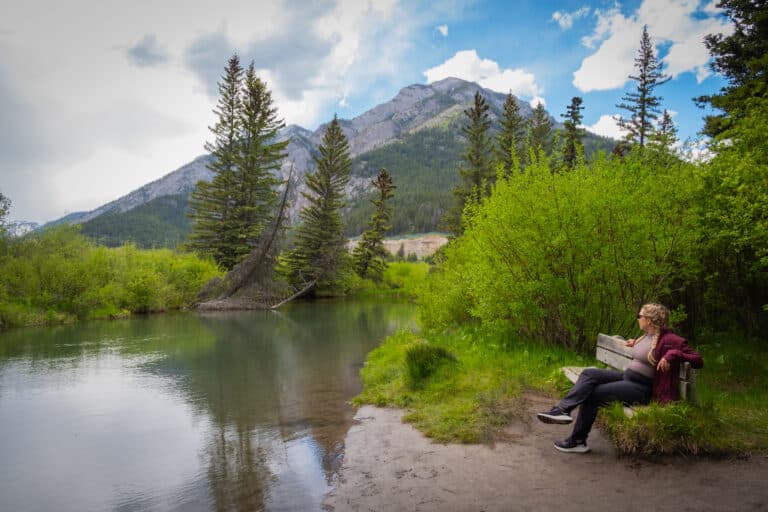
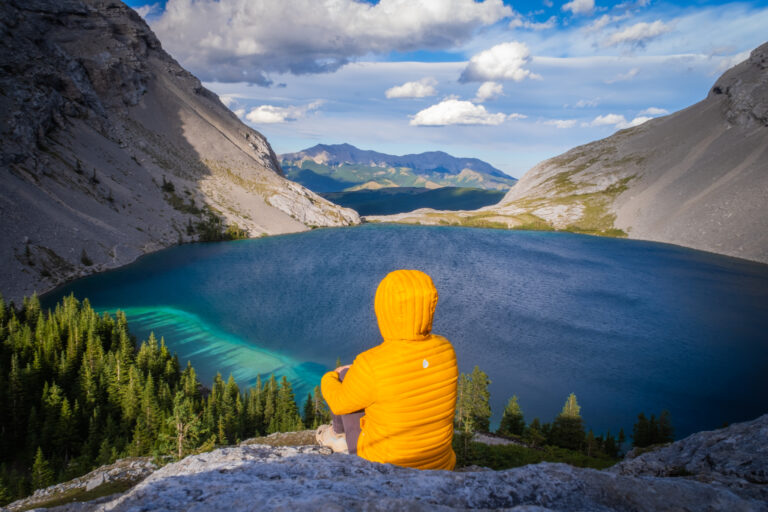
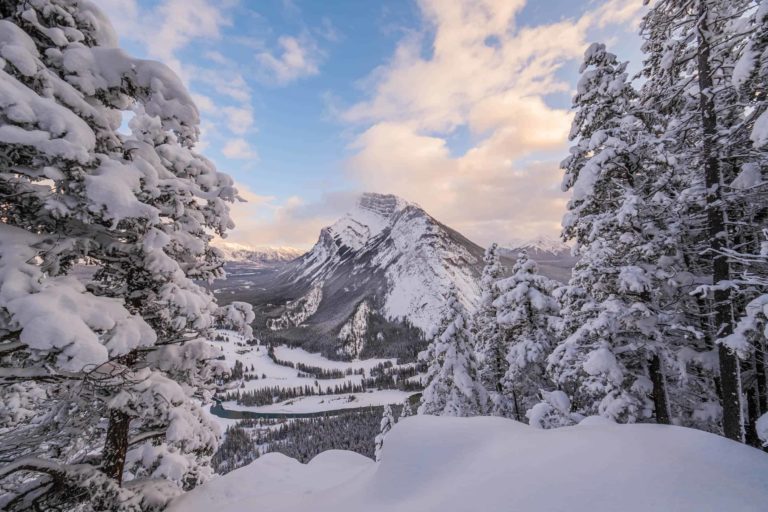
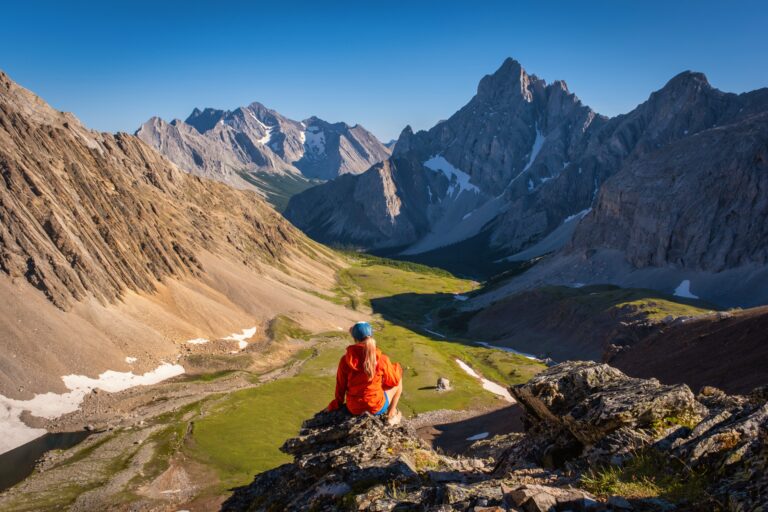
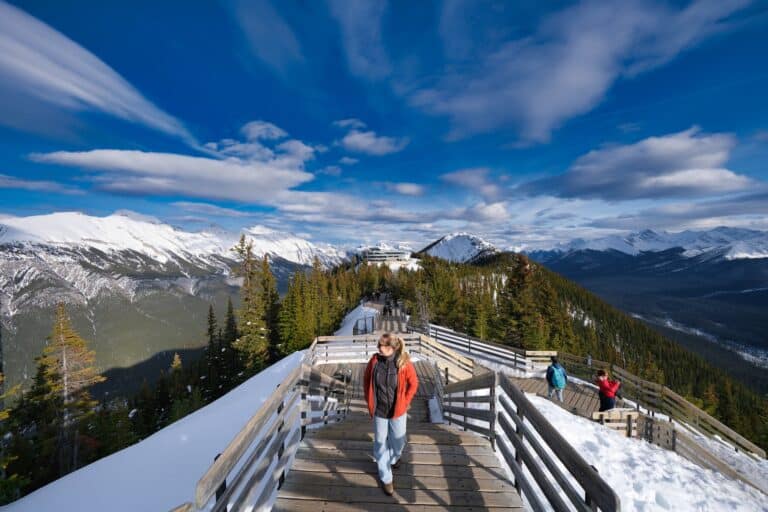
great informative blog, thanks for sharing
Thank you for all this great information. I’m just starting to hike with a group and rather than ask 10 people what they’d recommend, I believe I’ve found all I need here!! I own some items you mention, but needed more understanding of other specific ones. Got what I was looking for right here. Great recommendations!!
so glad it was helpful!
Thanks for detailed blog. You guys are amazing.
glad it helped!
Thanks for this post! I am overthinking my shoe choice for sure. We’re doing Whistler, Jasper and Banff soon and have booked the Ridgewalker Via Ferrata in Banff. Do you think the Merrell Moab’s will be good enough?? I did just buy the Oboz X low Sawtooth but thinking of returning for the Merrell…
Any thoughts?? Should I get a actual boot vs. shoe??
Hi Shannon,
I’ve never tried Oboz, but I do love my Moabs, which come in ankle length boots as well as a more shoe type version. I’m unsure what kind of hikes you have planned. Typically I love hiking in day hikes in my trail runners and then in my boots for multi day hikes. If you’re prone to rolling your ankle I could go with the boots.